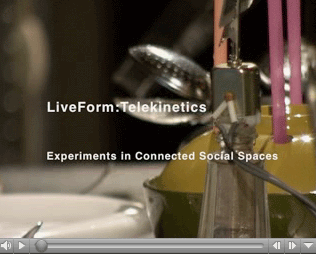June 11, 2007
Telematic Dress
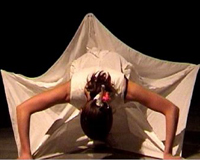
Distributed Proprioception
Abstract: Centered around several short films from streaming performances created in 2005, this paper explores new ideas for movement technologies and garment design in an arts and digital research context. The "telematic dress" project, developed at the DAP Lab in Nottingham, involves transdisciplinary intersections between fashion and live performance, interactive system architecture, electronic textiles, wearable technologies, choreography, and anthropology.
The concept on an evolving garment design that is materialized (moved) in live performance originates from DAP Lab's experimentation with telematics and distributed media addressing "connective tissues" through a study of perception/proprioception in the wearer (tactile sensory processing) and the dancer / designer / viewer relationship. This study is conducted as cross-cultural communication with online performance partners in Europe, the US, Brazil and Japan. The inter-active space is predicated on transcultural questions: how does the movement with an evolving design and wearable interactive sensors travel, how does movement - and capturing of movement - allow the design to emerge toward a garment statement, and how are bodies-in-relation-to sensory fabrics affected by the multidimensional kinesthetics of a media-rich, responsive environment." From The Telematic Dress: Evolving garments and distributed proprioception in streaming media and fashion performance by Johannes Birringer and Michèle Danjoux. [via]
Posted by jo at 05:32 PM | Comments (0)
May 22, 2007
Haptic Telexistence
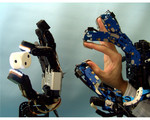
at SIGGRAPH 2007
Haptic Telexistence (SIGGRAPH 2007) provides highly realistic haptic interaction among humans and objects located in remote places. Human interaction will be dramatically improved by this concept, which perceives us as the properties of an object.
Enhanced Life: With conventional systems, we can only perceive the stiffness of an object. But with Haptic Telexistence, we can also perceive the exact shape of an object, and more natural and dexterous object manipulations become possible. This simplifies complex tasks such as telesurgery and 3D modeling.
Because this system can present properties such as texture and temperature, it will support dramatic improvements in human life. For example, not only will we be able to shake hands with people at remote locations but we will also be able to feel the warmth of their hands. While shopping on the web, we will be able to check the texture of an article before purchase.
Goals: Our ultimate goal is to present all the haptic sensations through a master-slave system. Using current telepresence systems, we can interact with humans or objects even if they are located in remote places or in virtual environments. We can watch, listen, touch, and move objects. However, the properties of an object are not present in these systems, and that reduces realism and interactivity. Haptic Telexistence aims to provide highly realistic haptic interaction among human and objects in remote places.
Innovations: The system consists of four innovative devices: a dexterous slave hand, q finger-shaped haptic sensor for the slave hand, an encounter-type master hand, and an electro-tactile display. Each of these devices has more advantages than the corresponding conventional ones. In addition, integrating them to realize Haptic Telexistence is also a technical innovation.
Vision: Because haptic and robotic technologies continue to improve rapidly, we believe that this technology will be fully realized with 10 years.
Contact
Katsunari Sato
The University of Tokyo
Katsunari_Sato (at) ipc.i.u-tokyo.ac.jp
Contributors
Kouta Minamizawa
Naoki Kawakami
Susumu Tachi
The University of Tokyo
Posted by jo at 09:01 AM | Comments (0)
April 19, 2007
The Reception

Performance + Discussion
A tele-immersive cross-disciplinary performance piece called The Reception will be presented April 20, 21, 27, 28 at 8pm and April 22, 29 at 2pm as a part of the Berkeley Dance Project 2007. The piece was created by the co-directors of SmithWymore Disappearing Acts, Lisa Wymore and Sheldon B. Smith in collaboration with Ruzena Bajcsy of CITRIS (Center for Information Technology Research in the Interest of Society). Live performance and streamed realtime 3d tele-immersive technology are used to poetically examine the subject of presence. BDP is an annual collection of danceworks presented by UCBerkeley's Department of Theater Dance and Performance Studies. Performances will take place at UCB's Zellerbach Playhouse theater.
The April 22 performance will be followed by a post-performance discussion: Being Here: Presence/Remote Presence within Live and Media Based Performance by N. Katherine Hayles. The discussion will feature a demonstration of a live bi-located dance utilizing the tele-immersion labs at UC Berkeley and the University of Illinois, Urbana-Champaign. Co-sponsored by the UC Berkeley Department of Theater, Dance, and Performance Studies, the Towsend Center Dance Studies Working Group, and the Dance Department and Intermedia Program at Mills College. The discussion is free and open to the public.
Posted by jo at 07:40 PM | Comments (0)
April 11, 2007
DEAF 07 Exhibition
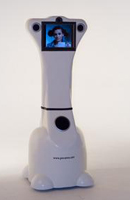
MOBI
MOBI (Mobile Operating Bi-directional Interface), by Graham Smith, is a human sized telepresence robot that users remotely control to move through distant environments, see through its camera eye, talk through its speakers and hear via its microphone ear. Simultaneously a life sized image of themselves is projected onto the robots LCD face, creating a robotic avatar. MOBI allows people to "explore far away art shows, attend distant presentations and make public appearences from anywhere on earth, thus helping to reduce air travel and reduce global warming". MOBI is at DEAF 07.
Graham Smith is a leading expert in the fields of telepresence, virtual reality, videoconferencing and robotics. He has worked with leading Canadian high tech companies for more than 14 years, including Nortel, Vivid Effects, VPL, BNR and IMAX. Graham initiated and headed the Virtual Reality Artist Access Program at the world-renowned McLuhan Program at the University of Toronto, and has lectured internationally. He holds numerous patents in the field of telepresence and panoramic imaging, and was recognized in Macleans magazine as one of the top 100 Canadians to watch.
Posted by jo at 10:13 AM | Comments (0)
March 21, 2007
Virtual actors take to the stage
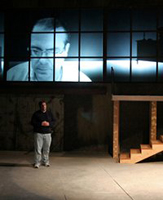
"Beamed" from Florida to Illinois
"Actors working in real time from remote locations have been beamed onto a stage where they performed with live, in-the-flesh actors, US researchers say. The broadband-enabled experience allowed the audience to watch a seamless, 3D performance, according to the University of Central Florida. The technology could mean future theatergoers might attend plays where one or more actors are working outside the venue, even in a different country, or from their own homes. "We are not talking about holograms yet or the kind of imagery that requires funky glasses," says Professor John Shafer, a member of the cast. "[But] what we have done for this production has indeed pushed the envelope significantly. The production is a small historical step forward on several levels."
Shafer was hooked to a receiving and transmitting broadband-connected computer that can pull 130 megabytes of data in an instant. Although he performed in Florida, his body was 'beamed' onto a stage at Bradley University in Illinois, where he performed 'with' live actors there, as well as with actors beamed in from the University of Waterloo in Canada. Both 3D and 2D sets consisting of multiple screens and special-effects lighting that helped to give the impression that all the actors, remote or not, existed in a single space." Continue reading Virtual actors take to the stage by Jennifer Viegas, ABC Australia News In Science. [via]
Posted by jo at 08:41 AM | Comments (0)
February 19, 2007
In-Site Montréal

Hotspot Interventions
In-site Montréal: Curator’s statement by Michelle Kasprzak :: In-Site Montréal is a collection of site-specific art presented on the portal pages of five wireless internet (Wi-Fi) hotspots in Montréal. Artists Nicolas Fleming, Maria Legault, and Virginie Laganière have created artworks that may be viewed when users of the free service provided by Île Sans Fil log in to their accounts at the selected hotspots.
The five hotspots are rooted in specific spaces, each one with its own unique properties. The In-Site Montréal project grew out of a desire to augment the experience of place for Wi-Fi users, offering an additional layer of information within the hotspot environments. The artworks that are presented on the portal pages are inventive responses to the characteristics of the spaces that the hotspots inhabit.
“The window appears to look out onto a dataspace that continues beyond the borders of the window itself. [...] But the illusion quickly wears off. The window starts to feel more two-dimensional, more like a piece of paper than a portal. The view-space appears to flatten out, to the point where the window and the data contained within the window merge.”i
Here Steven Johnson is describing the effects of using a scrolling window on a computer screen for the first time, and I am referring to it (ever so slightly out of context) to illustrate a point about the works that are being presented within In-Site Montréal. The users of the Île Sans Fil wireless network are, arguably, all hardened internet users, for whom the complexities of scrolling windows and portals and most other graphical user interface-related things are trivial.
However, since they have reached the secondary stage that Johnson refers to, where the “window and the data contained within the window merge”, there are certain expectations for an experience that can keep pace with their ability to leap from hyperlink to hyperlink.
Portals, by and large, are clumsy. The portal that occasionally pops up on my screen, which is associated with my Hotmail account, assumes I am interested in all manner of celebrity gossip and sports scores, and regional news for an area that is 45 miles to the west of where I currently live. But the works presented as part of In-Site Montréal are not attempting to form part of a portal experience that would guess the preferences of each user. The works are dealing directly with the particularities of the site where the hotspot is, which is a small enough area to be clearly defined as a common element in each user’s experience. For the elite users, something at last may jump out at them from this flattened dataspace where things feel as twodimensional and familiar as a piece of paper. Instead of the usual hurried clicking to get past a familiar “roadblock” and get to the destination they intended to go to, they may now feel that the artists of In-Site Montréal have added an observation on their local café, library, or artist-run centre that matters, that they can respond to, that strikes them out of their reverie.
“A provisional conclusion might be that in advanced art practices of the past thirty years the operative definition of the site has been transformed from a physical location —grounded, fixed, actual— to a discursive vector—ungrounded, fluid, virtual.”ii
Parts of this definition of site – fluid, virtual – are key concepts that that In-Site Montréal works with. The layer of information that floats on top, as a meta- layer to the usual experience of café users in the Île Sans Fil network is meant to be something a bit fluid, virtual and unexpected. The only definition that it does not fit is that of “ungrounded”, precisely because it is the grounding in the site that sets this project apart. Maria Legault’s interventions with her Free Sugar project may be considered particularly grounded in the sites in question. She worked with two locations, Studio XX and Café Utopik, and developed an extension of her Free Sugar project around both locations. At Studio XX, a feminist art centre that primarily consists of an office space and computer lab, she created a performance event entitled the Free Sugar Salon, that was open for anyone to attend and have the holes in their lives filled with pink pudding. She filled cracks in the architecture of Studio XX with pink icing, and then turned her attention to the attentive public that arrived at the studio, counseling them and filling their mouths with pink pudding to console them. At Café Utopik, a café/bar that regularly hosts bands and spoken word events, she conducted a surreptitious intervention, filling crevices and holes in the architecture and surrounding environment of the Café with pink icing, and documenting it in photographs. Both of these projects are presented on the portal pages of Studio XX and Café Utopik as video documentation of these actions.
Artist Virginie Laganière focused on two very different areas: the Jean-Talon Market and the area around the popular meeting place, Café Utopik. Her site-specific video pieces were shot with regular video cameras, as well as custom camera rigs attached to her body. She then manipulated the footage further in the editing suite, adding her own compositions as soundtracks and prolonging moments that happened oncamera, providing us a moment to reflect on their significance. She specifically chose to document moments where people were not as present in these spaces, and where the patterns of movement in the “off-peak” hours would become more apparent.
Through her augmentations in the editing suite, she also aims to create a piece of work that allows us to see beyond our usual clouded and harried view of the urban environment, and enjoy a view of the built environment that is tranquil, constructed, and part of an aesthetic experience. In particular, her video piece presented on the portal page of the Jean-Talon Market, usually a place so buzzing with activity as to be nearly impossible to navigate, was shot in the very early hours of the morning, when market stall owners are setting up. This meditative and slow period of the Market’s activity is hidden from most of the Market’s patrons, and Virginie’s artful editing brings out the poetry in the stasis of these moments.
Nicolas Fleming's performance art videos also present us with an alternate view of our public spaces. His work is presented at Café Kafeïn and Laïka, because of both the subject matter that he chose and the locations that he performed in. At Laïka, an extremely popular and hip bar/restaurant/club, he presents se traîner, a piece wherein he drags himself out of his apartment (which is within the same building complex that Laïka is in) and down the stairs to an escape portal – an automatic garage door. Throughout the performance he can be heard grunting with the strain of moving himself in such an unconventional way, and by the end of this performance, he is clearly exhausted. Users viewing this video must marvel about this strange and strenuous test to his body, that took place in relative secret behind the scenes of the Laïka’s festive décor. In the other piece, traîner un dj, Fleming travels to Île Sainte-Hélène to encase a dj in a canvas sac, and drag him along the pavement, with the sounds of Piknic Electronique (Montréal’s outdoor summer dance club) pounding in the background. This work is presented at Kafeïn due to the dj culture that is resonant there; the dragging of a dj must be somewhat humourous to the clientele.
Telematics is a term used to designate computer-mediated communications networking involving telephone, cable, and satellite links between geographically dispersed individuals and institutions that are interfaced to data-processing systems. It involves the technology of interaction among human beings and between the human mind and artificial systems of intelligence and perception. The individual user of networks is always potentially involved in a global net, and the world is always potentially in a state of interaction with the individual.iii
The virtual spaces that In-site Montréal inhabit are amorphous areas around several accepted gathering places such as cafés, galleries, markets, and bars. They are perhaps places where as an internet user, you may intend to use the opportunity of connectivity to the network to look outward, to read news of distant places or connect with friends far away through e-mails and online social networking sites. The art practice of telematics in particular addresses the creative possibilities when two parties are connected over distance to communicate. In some way, the pieces presented on the portal pages of Île Sans Fil’s network as part of the In-Site Montréal project present something that is almost anti-telematic, in that the works look inward rather than outward. In the case of this project, a connection to someone across the globe is not sought, it is shunned in favour of a further examination and rumination on the details of the local environment. A local resident, who is perhaps used to the culture at Café Utopik, may be best able to chuckle at the video of pink icing being added to the sign above the door. This intense inwardlooking that these pieces commit to is the essential point of the project. Instead of seeking to look outward and connect with others who are in a radically different geographic space, In-Site Montréal hopes to reconnect locals with their own space, through the language of culture, compelling users of the network to turn their gaze inward enough to consider the cultural resonances that are possible.
- Michelle Kasprzak, 2006/2007
i Steven Johnson "Interface Culture: How New Technology Transforms the
Way We Create and Communicate" 1997 Harper Collins, New York. Pg 86
ii Miwon Kwon, One Place After Another: Notes on Site Specificity, October 80 (Spring
97): 95.
iii Roy Ascott: “Is there love in the telematic embrace?”
http://www.receiver.vodafone.com/07/articles/03_page01.html
Posted by jo at 04:05 PM | Comments (0)
January 24, 2007
Viroid Flophouse
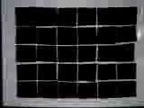
An Exploration of Playable Art
The Viroid Flophouse was an exploration of playable art in an online gaming environment, which incorporated movement, motion tracking, streaming technologies and telematic performance, within the common theme of "virus."
It was a hybrid game/performance environment created by ADaPT (Association for Dance and Performance Telematics) which includes among others Arizona State University (Tempe, Arizona), Nottingham Trent University (Nottingham, UK), Wayne State University (Detroit, Michigan) and Waag Society for Old and New Media (Amsterdam, NL).
The sites functioned as rooms in the "flophouse," in which on-site participants could interact with remote participants.
The ADaPT members involved in this production included a team from Arizona State, spearheaded by John Mitchell, a small team from Waag Society headed by Josephine Dorado, with additional input from Johannes Birringer (Nottingham Trent University).
Previous renditions of the project:
ADaPT had already experimented with one rendition of the project, named the Saira Virous which involved teams from Nottingham Trent University, headed by Johannes Birringer, and Wayne State University, headed by Kelly Gottesman.
Birringer's documentation of the Saira Virous can be viewed at the following urls:
http://art.ntu.ac.uk/performance_research/birringer/lat5.htm
http://art.ntu.ac.uk/performance_research/birringer/lat.htm
http://art.ntu.ac.uk/performance_research/birringer/lat4.htm
That rendition of the project mainly focused on the extension of dance performance telematically within an online gaming infrastructure, via streaming and projected media integrated with live performance.
The introduction of OSC (Open Sound Control protocol) into the gaming structure: In our rendition of the project, the goal was to enhance the interaction by incorporating the sending and receiving of OSC data (Open Sound Control protocol) combined with motion capture, into the scenario.
The incorporation of osc data transmission over a network, in combination with motion capture via softVNS, enabled the sites to communicate the performers’ positions to each other. That data, in turn, could be used to control game events.
The gaming structure: The game structure was developed and was based on the action of the remote and local gamer "sharing" the same space. In other words, the gamer in Arizona and the gamer in Amsterdam had to position themselves in the same virtual gaming space in order to get to the next level. The game was played by Arizona and Amsterdam players in this fashion, with supplementary commentary being streamed in sports commentary style, from Birringer.
Posted by jo at 09:45 AM | Comments (0)
RPM's Remixed
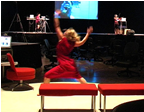
A Virtual Space "Sings"
RPM's Remixed is a telematic, transdisciplinary performance based on remixing Alvin Lucier's RPM's score – integrating dance, video and sound improvisation between artists in New York, Tampa, and San Jose.
Alvin Lucier, a well-known composer of music and sound installations that explore natural phenomena and resonance, is renowned for making spaces "sing." This piece explores the possibilities of using one of his scores to make a virtual space "sing" by using improvisational techniques as well as the natural feedback and delay created by streaming.
Themes exploring isolation, intersection, and madness reverberate through images, body and sound. Dancers and sound artists in San Jose, Tampa, and New York collaborate while realtime processing of the video images is driven partially by the performers’ movements. Motion analysis is sent over the network to trigger aspects of video manipulation, further blurring the lines of authorship and contributing to the impromptu chemistry.
Lucier’s original “RPM’s” score was a tongue-in-cheek take on creating sound based on depressing and releasing the accelerator of an Aston Martin engine. The score itself is a series of nonsensical curvatures and dashes – nonsensical, that is, until a personal interpretation of each written gesture is applied.
Taking this a step further, the cast of RPM’s Remixed deconstructs the score, into dance gestures, violin strokes, guitar riffs, and sound and video mashing. The challenge is not only to collaborate within one’s own medium but to improvise successfully between mediums and within a virtual space. Can the magic of improvisation reach across the ether? [via Rhizome]
Posted by jo at 09:33 AM | Comments (0)
October 11, 2006
nonetheless l'm still here

a stop motion telematic performance
nonetheless l'm still here, by Nurit Bar-shai, is an online performance in which participants control telematically a simple scene consisting of a curtain flowing in space. The work consists of an installation in the real world, the people who participate, and the website which bridges the two, providing both a live video feed and an interface for users to interact remotely with the scene. Every time a user clicks the curtain moves in small steps. Each change is recorded as a snapshot, creating not only an archive of the work but a collective, creative result: a stop motion animation sequence.
The curtain which this work features is akin to a marionette, and is controlled by a system of small motors. It moves in steps according to users clicks. These mechanical motions only change the scene slightly, but over time, they combine to move the curtain in a way which conveys the natural sway of real fabric. In this manner, the work examines the tension between the organic and the inorganic, as well as the controllable and the spontaneous.
My goal in this project is to examine how real time, telematic performance, in which objects are controlled collaboratively, can be used to explore the poetics of the common and everyday. While the interaction described here is simple -- a user clicks and a small physical change occurs -- in presenting this simple metaphor of a curtain, filtered through multiple screens, the work suggests a compelling image for people to project on.
Posted by jo at 08:16 AM | Comments (0)
July 07, 2006
INTIMATE TRANSACTIONS

Sensing Place Through a Complex Web of Relations
Presented by the Brisbane Festival 2006, and Centre Of Contemporary Art, Cairns and conceived and developed by Transmute Collective, Intimate Transactions is a new type of interactive installation that allows two people, located in geographically separate spaces, to interact simultaneously using only their bodies. As this highly immersive experience evolves through digital image, sound and tactile feedback, each person begins to sense their place in a complex web of relations that connects them and everything else within the work.
VENUES: The Block, QUT Creative Industries Precinct, Musk Ave, kelvin Grove & Centre of Contemporary Arts Cairns. DATE & TIME: Sat 15 - Sat 22 Jul; 11am - 2pm & 3pm - 6pm daily; Individual sessions every half hour. DURATION: 30 minutes per session. TICKETS: FREE event. BOOKINGS: Brisbane: 07 3864 5495; Cairns: 07 4050 9493.
Intimate Transactions has been shown extensively in Europe and Australia. It was awarded an Honorary Mention in the Prix Ars Electronica Interactive Arts category, 2005.
Transmute Collective are Keith Armstrong (Director), Lisa O’Neill and Guy Webster, and numerous key collaborators.
Posted by jo at 01:15 PM | Comments (0)
June 28, 2006
Worldbench

Uniting School Children Around the World
Worldbench, by Greyworld, is an ambitious art installation that uses park benches to unite locations around the world from Berlin to Newcastle, London to Cape Town.
Each installation is situated in a school and consists of a bench placed next to a wall onto which is projected the mirror image of the bench. However, whilst one side of the bench may be in the grey playground of a primary school in Newcastle the other is in the sun-baked play - ground of a school in Cape Town. The people sitting on the bench can have an idle conversation, discussing their lunch or perhaps indulging in a little light flirtation, which they would have were they sitting on the same bench and not separated by thousands of miles.
Several benches have been installed in five schools across the UK, one in a dynamic inter-racial primary school in Cape Town and another in a secondary school in Berlin.
Posted by jo at 07:09 PM | Comments (0)
June 05, 2006
When Ghosts Will Die
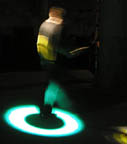
Stories Stitched Together "on the fly"
When Ghosts Will Die, a performance-installation that utilizes multi-sensory elements such as sound, video, light, and text controlled by motion-tracking technology, tells the story about the dangers of nuclear proliferation. Inspired by the play, "Copenhagen", by Michael Frayn, it explores the use of non-linguistic elements in the service of making poetry and telling stories. The artists and programmers involved on the project include Steve Gibson, Dene Grigar, Will Bauer, Jim Andrews, and John Barber.
"When Ghosts Will Die" involves one-two performers and envisions the space as a 3D grid simultaneously within a central computer and a physical performance space. The performers move through this environment and evoke the multi-sensory elements with hand-held tracking devices and in so doing interact with these elements through three potential phases of nuclear proliferation: 1) Disharmony, 2) Destruction, and 3) Disintegration. These three phases are intended to evoke the first nuclear explosion, the "Trinity" test in New Mexico on July 16, 1945, that took place just weeks before the nuclear bombs exploded over Hiroshima and Nagasaki, Japan.
Using the tracking device, the performers can move through the space choosing the element they wish to utilize for telling the story. In this way, the story takes on a rhapsodic quality: it is literally stitched together "on the fly" and changes wtih each telling. The mood of the space is designed to match the phase that the performers reach. Disharmony, for example, offers slightly discordant sounds that increasingly give way to cacophony, as well as video footage representing growing belligerence. Destruction sees the dropping of the bombs and corresponding sounds of buildings falling into rubble. The final phase, Disintegration, takes performers to the motif of the work: that the destruction derived from these weapons will be so complete that even "ghosts will die," an allusion to Michael Frayn's "Copenhagen" that sits at the heart of this project.
The story is meant to shock those participating into a deeper awareness of the horrors of nuclear warfare. Politically speaking, the work's message – that the development and deployment of weapons of mass destruction not only test a country's power but also its humanity – speaks to artists' "responsibility to envision alternative futures... and shape the way people think, live, and interact" (Edward Shanken). [via]
Posted by jo at 12:31 PM | Comments (0)
May 25, 2006
Mawhrin-Skel
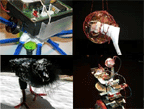
Autonomous Robots
Mawhrin-Skel--by Deanne Achong, Kate Armstrong, Joelle Ciona, David Floren, and Matt Smith, with help from Dina González Mascaró--brings together an eclectic group of local Vancouver artists, who work variously in new media, electronics, sculpture, installation and performance, to create autonmous robots that communicate with one another wirelessly via the internet.
The project--Sheryl [Crowbot] (DA), The Problem of Other Minds (KA), TangleBot (JC), Phono, Mono, and ChartBot (DF), RadBot (MS)--is based on a fictional character--"Mawhrin-Skel"--an intelligent drone that, having failed to meet the conditions of its original purpose, is decommissioned and left to wander aimlessly through a near utopian environment where it becomes a social nuisance and prankster. This character - invented by Ian M Banks in his 1989 novel "The Player of Games" - provides an interesting social and cultural entry point into the study of robots as both cultural artifacts and autonomous members of society.
Robots typically have industrial applications - wireless mines that can dig their way out of the earth and move to a "better" location, machines that cleanup radioactive waste or other hazardous material, surveillance equipment, toasters, coffee makers, etc. It is unusual to build a robot that doesn't have an overt industrial purpose - it may be decorative, dysfunctional, nailed to a tree and bleeping. It exists purely to raise questions about industrial and technological philosophies and ethics in our society. This project examines ideas of function, autonomy, artificial intelligence and purpose-driven technology.
These objects are intended to sit on window sills, desk corners, over doorways, nailed to a post on the back deck, in the gravel pit in the basement, etc. The wireless Internet connection allows the devices to talk to each other and mingle their conversations on the web. The "eyes" of one machine can influence the actions of another. Keywords can generate furious activity or silence. Following the series of workshops, the results of the artists' experiments with robots will be exhibited to the public through a number of events in May 2006 and January 2007.
The Mawhrin-Skel robots communicate with each other using the Scrambler - a message server that was developed in 2003 to connect electronic installation works around the world.
Posted by jo at 10:44 AM | Comments (0)
May 10, 2006
Blind Love
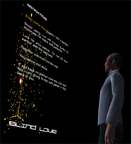
Extensions via Virtual World of Art
In Blind Love (click on Art), two visitors must find each other before they can find the way out of a pitch-black labyrinth. Each is armed with a weapon that shoots luminous particles. The particles explode on the walls and cascade into the corners, revealing the skeletal outline of the labyrinth's architecture. The two visitors must use the light emitted by their weapons to find one another, but-in an inversion of normal game logic-must not hit and kill each other if they hope to win. Like lovers, the visitors must blindly trust each other in order to survive, and must approach one another despite the danger.
Blind Love is one of the art works created for EXTENSION (click on Virtual World of Art, Extensions/SAT), a virtual architectural intervention that explores the potential of digital architecture to reveal and transform urban, cultural, and spatial identities. EXTENSION was created for the SAT in Montreal, one of North America's leading centres for new media. Visitors entering EXTENSION through the SAT terminals find themselves in a virtual space that mirrors their actual physical surroundings.

As they move through the environment, they cross from reality into virtuality, and from simulation into representation. Within the virtual environment, the existing building of the SAT has been recreated as a realistic 3D model. This simulation is transformed and reconfigured with the addition of a vast, zeppelin-shaped structure affixed to the roof. From inside this glass-encased space, visitors have a panoramic view of a virtual Montreal, where the city itself has been reconstructed with a poetic blend of realism and utopian fiction. Visitors to this near-real space discover experimental artworks in the halls and rooms of the virtual environment, and layered in other dimensions accessible through portals that brings the viewer into dedicated art installations. Anchoring virtual experience in real space, EXTENSION blurs the boundaries between imagination and perception. Grounded in the real but not limited to the realistic, EXTENSION is a reflection of the concepts and visions each of us forms about spaces and places.
EXTENSION is one of three nodes of the Virtual World of Art.

As technologically mediated experiences the Internet, games, cinema, television occupy ever more of our time and energy, it becomes increasingly vital that we create alternative spaces and environments for experience within these borderless territories of information and communication. Virtual World of Art invokes, manipulates and transforms the vocabulary and logic of game culture to create artistic engaging spaces which awaken aesthetic, emotional, social and intellectual responses radically different from those engendered by contemporary mass media. The project explores a variety of significant problems that cultural institutions committed to artistic practice within a networked electronic environment continue to face: how to create esthetically compelling and emotional online experiences, how to link physical and data spaces together, and how to effectively enable human communication and exchange in a physical space where local and remote visitors and performers can communicate virtually through technologies and computer interfaces.
Virtual World of Art investigates the artistic possibilities of immersive game technology and proposes new models for experiencing architectural and public spaces, sociability, and cultural production. Grounded in reality but not limited to realism, Virtual World of Art forms a dynamic, socially relevant, independent alternative to the existing art world, enabling artist to emancipate and develop a critical view of the future and meaning of contemporary art.
Virtual World of Art is the title for a series of new media art projects which subvert and reconfigure multi player game technology to create a network of artistic virtual environments. Each of these virtual environments called nodes, containing digital artworks and virtual art installations, is associated both conceptually and thematically with a specific site, arts centre or a public event where the project is presented on a long-term basis. These virtual environments are connected together by the internet forming a new kind of enlarged social and experiential public space for artistic expression and social exchange.
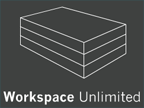
VWA will connect at least 3 locations or nodes in order to function as a complete project. Each node explores a different notion of hybrid between physical and virtual public space. Visitors will be able to interact through terminals installed at the nodes or at any public space in the world that has a high-speed internet connection.
Virtual World of Art is a project of Workspace Unlimited.
Posted by jo at 10:57 AM | Comments (0)
April 25, 2006
Nowhere
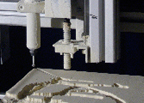
Rhizomatic Sculpture
To be born, grow up and die. All in three weeks. This is the vital cycle of Nowhere, electronic landscape conceived by Ralf Baecker. It's a net project, based on a search engine results (a concept originally developed here and later experimented also in Emailerosion). In Nowhere the user does his searches on the German Metager. For every accomplished search a mechanical arm is activated, eroding a block 75x75x10 cm made out of PU Foam, that can be seen in a window on the website. Depending on the time spent to index the data, the arm's eroding movement will be slower or faster. Rivers, canyons, valleys... the created topography exists only for the research time period.
The simultaneity of the different connections and the alternation of day and night (that usually corresponds to a major or minor net access) influences the transformation rate. The opportunity to noticeably modify a sculpture that's visible online only enhances the relationship between the contemporary artistic expressions evolutions and the virtual reality potential. In this case the space / object is transformed in a space / image. The interaction and man / work reaction can be tuned and manipulated without physical, temporal or representative limits. The work assumes a rhizomatic character, that is to say a network of polymorphic entities with different access points. This is the result of an interaction amongst heterogeneous elements, developing an internal non-hierarchical communication, or in other words the path mapped out with the connected users' cognitive links. Francesca Tomassini, NEURAL
Posted by jo at 08:56 AM | Comments (0)
March 12, 2006
M/C Journal: transmit

Transmitting the Body in Online Interaction
"Cyberspace is much celebrated because it is viewed as a disembodied realm of social interaction. The identity adopted in a chat room or a message board need not bear any resemblance to the physical, corporeal and material body that is so important in face-to-face interactions. This is seen to confer a transgressive potential to the individual to explore aspects of the self, particularly with regards to sexualities and gender identities which may otherwise be liable to stigma. However, to conceptualise cyberspace as disembodied actually involves a ‘very narrow construction of how we should conceive of this space and the activity that occurs within it’ (Whitty 344). In fact, a central tenet of online interaction rituals is the transmission of the body. The popularity of chat programmes (such as Microsoft Messenger), chat rooms and online dating sites necessitates individuals to construct and transmit the self to others through text. However, drawing on the work of Goffman, this article notes that such transmissions are frequently problematic. In particular, the content of transmission is often subject to ‘framing troubles’, can be purposefully falsified and, as such, may be regarded with suspicion." From Transmitting the Body in Online Interaction by Danny Beusch, M/C Journal, Volume 9 Issue 1, March 2006.
Posted by jo at 12:17 PM | Comments (0)
March 10, 2006
Emailerosion
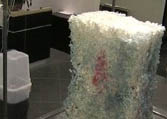
Corroding Materials and Boundaries
A biodegradable sculpture, available to anyone who wants to contribute to shape it remotely. That's how Emailerosion looks. It's a installation conceived and built together by Ethan Ham, a sculptor, and Tony Muilemburg, a robotic designer. The sculpture is real, consists of a big block of soap, and it'll be exhibited in the Portland Art Institute's Gallery. But if you want to enjoy it, you have to be in the virtual territory. Sure enough you can shape its form simply sending a mail to a specific address. Depending on the mail content the sculpture, whose image is streamed online, will vary its position and will rotate, or it'll get a splash, that'll erode a part of it. Moreover, thanks to the online archive it's possible to search all the modifications occurred during time, that led to the latest configuration.
The work, even if it exists physically whatever the individual does, enlivens, lives and evolves as the time passes thanks to the individual actions. From being a simple spectator he becomes a co-author, becoming part of a dynamism and mutation poetics. This metamorphic ability materializes in the possibility of producing sensible modifications through virtual instruments, becoming central in the work's existence. It constitutes the innovative core, corroding some of the art privileges, as the 'unicum' and the 'absolute'. It reduces the ideological distance amongst the work of art, the observer and the environmental context, starting to connect this poles through poetics and technological resources. [posted on NEURAL]
Posted by jo at 10:11 AM | Comments (0)
November 10, 2005
Transmute Collective
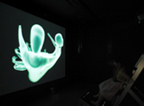
Intimate Transactions Between London and Greece
The Transmute Collective (Keith Armstrong (Dir.), Lisa O'Neill and Guy Webster) and their collaborators announce that Intimate Transactions (a networked interactive artwork) will be next shown simultaneously between the Institute of Contemporary Art, The Mall, London & BIOS (New Synthesis of Urban Culture), Athens, Greece. Date: 12 Nov - Wed 23 Nov 2005; 12 - 8pm UK GMT.
Intimate Transactions is an exciting new form of interactive installation that allows two people in separate spaces to interact simultaneously using their bodies. Each participant uses a physical interface called a Bodyshelf. By gently moving their bodies on this smart furniture they instigate Intimate Transactions, which influence an evolving world created from digital imagery, multichannel sound and tactile feedback.
Intimate Transactions was awarded an Honourable Mention in this year's Prix Ars Electronica in the Interactive Arts Category. Transmute pay tribute to all of the artists, staff and partners involved in making this project possible over the past four years.
Look out for the forthcoming ACID book/dvd, edited by jillian Hamilton: Intimate Transactions: Art, Interaction and Exhibition within Distributed Network Environments. For more details email ITBook[at]embodiedmedia.com
We particularly thank our major partners for this showing: The Australasian CRC For Interaction Design, Arts Queensland, The Institute For contemporary Art, BIOS and the Australia Council New Media Arts Board. Keith and Guy will attend this event courtesy of Arts Queensland, the ICA and BIOS.
This project has been assisted by the Australasian CRC For Interaction Design (ACID), the Australian Government through the Australia Council, its arts funding and advisory body & the Queensland Government through Arts Queensland. Intimate Transactions was developed with support from the Performance Space Headpsace Residency Program.
Posted by jo at 09:06 AM | Comments (0)
October 31, 2005
A conversation between...
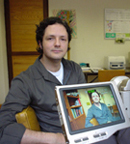
José Luis Barrios and Rafael Lozano-Hemmer
* This is the edited transcription of a teleconference which took place in the Sala de Arte Público Siquieros (SAPS), Mexico City, on the 20th of April 2005, and which was moderated by the director of SAPS, Itala Schmelz. Translation from the Spanish original by Rebecca MacSween.
JLB: The distinguishing factor that defines modernity has to do with self-awareness, or the ability of the subject to both represent and represent self-reflexively his activities and relationships with the world. An important aspect of this is expressed in the Foucaultian concept technologies of the gaze. Throughout the history of art and visual culture various strategies of the gaze have existed. How do you distinguish and conceptualize those strategies that belong to the present and how are they manifested in your work?
RLH: New visual experiments have always been aided, or even initiated, by technological advancements. For example, perspective during the Renaissance, anamorphosis as part of Mannerism, or Eugène Chevreul's color theory for the Impressionists. In this context my contribution is the following: Walter Benjamin spoke with great clarity about the birth of modernism. For him the image is that which can be reproduced mechanically, a condition that eliminates the aural quality from a work of art. Mechanical reproduction democratizes art, popularizes it, and takes away that privileged point of view born of singularity. However, with digital technologies I believe that the aura has returned, and with a vengeance, because what digital technology emphasizes, through interactivity, is the multiple reading, the idea that a piece of art is created by the participation of the user. The idea that a work is not hermetic but something that requires exposure in order to exist is fundamental to understand this "vengeance of the aura".
Today digital art, -actually all art-, has awareness. This has always been true, but we have now become aware of art's awareness. Pieces listen to us, they see us, they sense our presence and wait for us to inspire them, and not the other ay around. It is no coincidence that post-modern art emphasizes the audience. In linguistic theory Saussure would say that it is impossible to have a dialogue without being aware of your interlocutor. Exactly the same thing was said, almost 100 years ago in the art world by Duchamp, for example, when he said, "le regard fait le tableau" (the look makes the painting). What we see happening is that this concept of dependency is reinforced by digital technology. Pieces of art are in a constant state of becoming. It's not that they "are" but that they are "changing into". I think the artist no longer has a monopoly over their work, or an exhaustive or total position over its interpretation or representation. Today, it is a more common idea-an idea that I defend-that the work itself has a life. The work is a platform and yes the platform has an authorship, but it also has its points of entry, its loose ends, its tangents, its empty spaces and its eccentricities. In this sense, artworks tend to be eclectic which for me signifies the liberation of art, the freedom to reaffirm its meaning.
In contrast to the idea of creation through the gaze of the public, the other side of the coin should also be mentioned; the panoptic computerized gaze. Artistic interest in criticizing the predatory gaze of the surveillance camera is nothing new; there is for example the work of Dan Graham, Bruce Nauman or Julia Scher, to mention a few. What is new is the degree of computerization that the new surveillance systems, which invade our public and private spaces, possess. Stemming directly from the American "Patriot Act" is a wide variety of computer-vision techniques that, for example, are intended for identifying suspicious individuals or classifying them based on ethnic traits. It is literally about technologies designed to discriminate based on a series of innate prejudices. This new intensification of surveillance is extremely problematic because, in the words of Manuel DeLanda "it endows the computer with the power of executive decision making". What is also new is the amount of memory that these systems have thanks to ever-smaller storage units and increasingly efficient compression-decompression algorithms (codecs) that allow for the recording and reproduction of events from the distant past. Lastly, the widespread popularization of cameras by reality shows and the penetration into public and private spaces by means of things like web cams should be mentioned. I have no doubt that a new type of art is emerging in order to confront these technologies of the panoptic and post-optic gaze. The Institute for Applied Autonomy, Harun Farocki and the Bureau of Inverse Technology are some examples of this new line of inquiry.
JLB: A fundamental aspect of the connection between technology and language is that which is linked, and this is particularly important in your work, to society. If the machine is language and a space for play, how can we understand its function or connection with social bodies? Let me clarify; in a large part of your work, interventions into the space of the subject are obvious, whether these spaces are public or private. This is interesting because at the same time that you link technology with language (society), you also introduce a type of "principle of intrusion of technology" to both the subject and their space. What imaginary social space do you believe your work opens? Above all I am asking about those pieces that have a direct link to public spaces.
RLH: It depends on the project and how it is received. Often the response to the work is very different from what I had imagined. For example, my installations using giant shadows; the first time I used the projected shadows of pedestrians in a public art piece was when transforming the fa?ade of a military arsenal in the Austrian city of Graz. It happened that in the arsenal there was a painting entitled "The Scourges of God" depicting the three primary fears of the people of Graz in medieval times: a potential Turkish invasion, the Bubonic plague and infestation by locusts. For this installation I invited dozens of artists and thinkers from all over the world to participate in an on-line debate on the transformation of the concept of fear. Perhaps the Turkish threat had been replaced with a fear of an invasion of Yugoslavian war refugees, or instead of Bubonic plague, the current day AIDS epidemic. The debate was projected in real time onto the facade, but I thought I could use the shadows of the pedestrians as a kind of "window" or "scanner" linking the public to the text. I assumed that the shadows would give an expressionistic and lugubrious touch to the piece-I was thinking of Murnau. Also, I wanted the shadows to function as metaphors for fear: for instance fear of the Turkish invasion that never happened but was only a menacing specter. I was totally wrong! As soon as people passed by and noticed the installation they would start to play with their shadows and perform humorous pantomimes. The huge dimension of the shadows allowed, for example, for school children to step on their teachers, or that a man in a wheelchair could roll his twenty-five-meter-high shadow over the others deriving great pleasure from squashing them with his giant wheels. The installation was converted into an ad hoc carnival and nobody thought for one minute about fears, plagues or invasions. This was one of the most entertaining errors of my career. The piece, which was called "Re:Positioning Fear", opened a Bakhtinian carnavalesque space where the environment was artifice and game, an environment that was completely outside of my control, literally and poetically.
My projects with shadows since then have benefited greatly from this lesson. "Body Movies", the piece in which shadows reveal enormous photographic portraits, precisely invites people to play with their representations in a public space and to play at being the "other", like a kind of inverse puppetry. The plastic potential of the shadow is used not as an absence, loss or darkness, but as a window to an artificial reality. We were trying to interrupt convention, routine, the predominant narratives of power that the buildings represented. Cicero said, "We make buildings and buildings make us". Our situation in the globalized city says the opposite: the urban environment no longer represents the citizens, it represents capital. Architects and urban developers build with the priority to optimize cost, and from there to the homogenization of globalization, and from there to the unfortunate reality of contemporary architecture which fetishizes the modular, the formula. It has reached a crisis of representation that carries with it a tremendous avidity of connection. In my work I try to encourage exceptionalism, eccentric reading of the environment, alien memories (meaning, those that don't belong to the site). don't want to develop site-specific installations but rather focus on the new temporal relationships that emerge from the artificial situation, what I call "relationship-specific" art.
JLB: In understanding public space as a carnivalesque space it is also understood why communities developed where-and this also happens with Relational Architecture-there is no subject identified as autonomous and independent. Bakhtin explains in his text on the forms of the carnivalesque in the Middle Ages and the Renaissance that in order for the carnival to succeed there has to be an overflowing beyond the limits of the subject's identity and body. It seems to me that in the examples you provide you reconstitute the carnivalesque condition by means of shadows, not as theatre but as pantomime. What you do is create a carnivalesque space in which the user can intervene and symbolically create a collective body. This is noticeable, for example, in the fact that you intervene facades or the Z?calo Square in Mexico City; by doing so certain symbolic connections to power are deconstructed. In this manner you open a ludic space and deepen the potential of the social body, but you do this via interactive technological supports, reinforcing the imaginary-fantastical aspect of the game. Seen this way, and to delve more deeply into the relationship between the public space and that of the carnivalesque, what place does the orgiastic body have in this game?
RLH: My projects vary so it is difficult to generalize. There are pieces where the body is amplified on an urban scale (Displaced Emperors, Body Movies, Two Origins), others where the body is the canvas (Subtitled Public), and others where it becomes the target of extremely predatory electronic detection (Surface Tension, Standards and Double Standards). There are also others in which the body plays no highlighted role (Amodal Suspension, 33 Questions Per Minute, Vectorial Elevation).
I'd like to make a clarification on a term you used and that is the idea of the collective. I run away from this idea. In the world of electronic art there are two competing trends. On the one hand the unbearable utopian vision of Pierre Levy, amongst others. He proposes a "collective intelligence", virtual communities that form a global village, the idea that we are facing the emancipation of the human race all thanks to inter-connectivity. To me this vision, which is promoted by publications like Wired, is corporative, colonial and naive. I am amongst the ranks of those that reject the notion of community and the collective when it comes to acts of interpretation or perception. I think that we have seen truly disheartening agendas produced in the name of collectivity. In contrast, I really like the concept of the connective -a much less problematic word because it joins realities without a pre-programmed approach. What's interesting is that this concept doesn't convert realities into homogeneity. What Derrick de Kerckhove calls "Connective Intelligence" seems more useful as a concept for linking planes of existence that may be extremely disparate even if they coexist at times. I would even go so far as to define the connective as those tangents that pull us out of the collective.To return to the connection between carnival, body and public space, "Body Movies" is a piece that inspired different behaviors depending on where it was presented. When it was to be shown in Lisbon I thought of the stereotype of the "Latino" who loves to be out on the streets, partying and hugging affectionately so I expected a lot of this type of interaction with the piece. However what we saw was people trying their best not to overlap or interfere with another person's shadow. In contrast, when we presented the piece in England, where I had thought we would see considerable modesty and moderation, people got drunk, took off their clothes and acted out a variety of orgiastic scenes, which was a lot of fun to watch. This anecdote points out the difficulty of making generalizations about the body in a public space, which seems to me like quite a healthy difficulty.
JLB: In your work you make a distinction between "Relational Architecture" and "Subsculptures". Does this distinction correspond to certain connections that you maintain or establish with specific aesthetic systems-architecture or sculpture-or perhaps to formal concepts, for example, scale, or is it more about two arbitrary concepts that allow you to explore diverse issues?
RLH: They are more about arbitrary concepts. They are neologisms designed precisely to avoid being classified with other existing concepts. I first used the term "relational" in 1994 in describing my telepresence installation "The Trace". I found the word in the neurological essays of Maturana and Varela, although I was also aware of pioneering artists like Lygia Clark and Helio Oiticia and their work with relational objects. As well, I was interested in the relational functions of database programs that wove multi-dimensional webs for connecting various fields, a valuable concept when applied to the word "architecture" that for so long has signified solidity and permanence. Lastly, it was a good word in counterpoint to the term "virtual", which emphasizes the dematerialization of experience and asks us to create in simulacra. "Relational" emphasizes the dematerialization of the real environment and asks us to question the dissimulation. Today the term is already dated, partly because of the popularization of the term "relational aesthetics" by Nicolas Bourriaud, which by the way has little to do with my work and was published a number of years after I used the term. For the sake of coherence with my earlier work, I will probably continue to make Relational Architecture pieces maintaining the two grotesque definitions that I gave to the field: "technological actualizations of urban environments with alien memory" (1994) and the newer "anti-monuments for public dissimulation" (2002).
I started the series of Subsculptures in 2003 with the motorized belt piece "Standards and Double Standards". I have already added another three to the series: the kinetic sculpture "Synaptic Caguamas", the interactive screen piece "Glories of Accounting" and the neon piece "Entanglement". It's true that in the majority of cases these are more portable and nomadic pieces than the Relational Architecture installations are, -however I think that at some point I will make huge Subsculptures... so, the scale isn't the difference. I don't yet have a definition of what "Subsculpture" is but I think it has to do with contagion matrices. All of the installations consist of two or more interconnected robotic or virtual entities. The rules of behavior for these entities are relatively simple, but they are dependent on and influenced by the status of neighbouring entities or other inputs, for example the surveillance of the public (my installations almost always "watch the watchers", as Daniel Garcia And?jar would say). In this way, they achieve an unpredictable and emergent global behavior, where turbulence and other phenomena that are products of non-linear processes are found. For example, in "Standards and Double Standards" there are between 10 to 100 buckled belts hung from interconnected robots. A computerized camera system detects a visitor and instructs nearby belts to rotate on their own axis until the belt buckle faces him or her. This local movement then spreads in a process of chain reactions that travel throughout the matrix until the entire field of belts has been affected. If a second visitor enters, then those belts closest to this second presence will be influenced and begin to rotate in the same manner described spreading and influencing the orientation of the entire field. The resulting effect are patterns of interference very similar to those that can be seen, for example, in a tank of water into which various drops fall; some belts remain still, others turn constantly (eddies) and others follow the spectators.
Another aspect of Subsculptures is my interest in Barbara Liskov's "Substitution Principle" that says, in object-oriented programming, that an object of one class can be substituted for another in an inherited class without changing the properties of the program. It's something like the concept of metonymy in psychoanalysis or linguistics and like the categorical syllogism in philosophy called the "minor premise" or "subsumption". Liskov's Substitution Principle is, for me, extremely useful when it comes to making symbolic transferences between disparate or copresent realities. For example in "Standards and Double Standards" the belt substitutes the figure of masculinity, the father, authority. I'll give you other examples: in "Synaptic Caguamas" beer bottles play at being neurons in an algorithmic simulation of cerebral connections; in "Glories of Accounting" the raised hands are both metaphors of the Fascist salute and of the Spanish anti-terrorist gesture of "manos blancas" ("white hands"), -the hands also simultaneously signify distance (as in a "stop" gesture) and inclusion (as in the expression "show of hands"); and a last example, Entanglement, in which the neons connected to the Internet substitute for the photons linked by quantum mechanics.
Contrary to what the Substitution Principle asks for, in my Subsculptures substitution has a formal impact: it leaves a symbolic residue and destabilizes equivalencies. This residue is the strength of the piece, its poetry and its absurdity. For this reason I propose anti-modular strategies for artwork. I like breakdowns, the remainder in a division, and rounding errors. I find modularization boring and homogenizing. Modularization is promoted by:
* Computer science, through object-oriented programming, or plug-ins
* The art world, through the idea of authorship and bienialism
* Capital, as an instrument of control and quantification
* Architecture, using the formula as a solution (see Norman Foster)
* Education, through the modernist idea of specialization
No doubt my work is often quite modular, above all in its fabrication and sale, and it's better to confess it even though it is a contradiction, because one cannot live outside of the zeitgeist.
I think that Relational Architecture, like Subsculpture, can exhibit the anti-modular, symbolic inequalities or develop itself in the matricial space of rules of contagion. So there is no definite line that separates the two series. It is true that the Subsculpture series is slightly more personal; perhaps it is more an investigation of psychological spaces than of urban ones. I have been doing psychotherapy for four years now and maybe that explains that!
JLB: I would like to go back to the problem of non-linear mathematics and its relationship to "Synaptic Caguamas". When information is flow, a multi-perspectival flow that unfolds in various dimensions, it introduces the notion of "possibility" as a form of construction. It's interesting to me that this piece is not built on random relationships but that it is more about variables and vanishing lines configuring the system of representation. Keeping this in mind, I would like you to explain how this flow of information operates aesthetically as a system of self-management and self-configuration.
RLH: Recursive algorithms, chaos theory, cellular automata, digital genetics and other descriptions of complex dynamic processes are fascinating because they appear to be alive, to have life. Some exhibit evolution, others morphogenesis, and still others management and self-control. Mathematics associated to this field originate from various places, one of them being Weiner's postulation of the theory of Cybernetics in Mexico City in 1946, -it's definitely not something new. If during the Renaissance perspective and Fibonacci's series were used as media to legitimize the production of representation, today we can and should make dynamic mathematics our media. The Renaissance subject emerges precisely from the privileged vision of the vanishing point. What might be the equivalent impact as we contemplate, say, a fractal pattern? These mathematics shatter humanism, fortunately. They allow artists to design work that disobeys us (and the critics).
Until these mathematics reached the art world one of the only strategies that the artist had to create unexpected processes, for example a kinetic sculpture or automatic poetry, was chance. The people whom I most admire worked with chance in a very serious way -like John Cage or Marcel Duchamp- but I think that randomness is not that interesting anymore. Not even the greatest computer in the world could generate numbers that are truly random. Today we accept that the occurrence of a hurricane isn't due to bad luck but due to the consequences of a non-linear system of energy distribution (Lorenz's famous "fluttering of the wings of a butterfly on the other side of the planet"). Of course this doesn't mean that there is a destiny or that everything is predictable, it's exactly the opposite. These mathematics show us that uncertainty is inseparable from the system being observed, and artists love to work with uncertainty.
Today it is possible to create art from seeds, which actually is called "seeding the initial conditions" for a process, and then the work unfolds via mathematics in ways that you cannot control. You'll notice that every three minutes the bottles in "Synaptic Caguamas" line-up and reset themselves. This is done to give new initial conditions and to generate a variety of behaviors because on occasion the emerging patterns are boring or the bottles remain locked in what is referred to as "dynamic equilibrium".
Complexity describes processes like neuronal connections, genetic mutations, and the variegation of leaves. There is an infinity of examples of how non-linear mathematics permeate almost all of our natural and social history. Manuel DeLanda writes about how this dynamic flows can be used to understand history in a non-linear way, - -it's not about the selective recording of facts, dates and heroes, but rather it's about understanding history in terms of fields of attraction, of isobars, of influences, which is how non-linear math works. We want to visualize these flows, animate them, and evoke them so that they can help us give shape to our work.
JLB: "Subtitled Public" is a piece that isolates chance. When we were speaking about the piece a while ago, you said that it was a little like Mallarme's roll of the dice. One roll of the dice, as in this piece, puts in motion a mechanism where poetry, theatricality, technology and non-linear mathematics construct a complex space of meaning. A space where language names me and, at the same time, the body is interpreted as a shadow. How do you explain the connection between intrusion and evasion in this piece when it is a metaphor for the society of surveillance? What importance does the interaction of the spectator have with the piece as a sort of "subversion" of the fact that in the contemporary world "I am named"?
RLH: Chance is present in "Subtitled Public": A visitor is detected by a computerized surveillance system and the computer randomly selects a verb, conjugated in the third person, and is then projected onto the visitor's body. The visitor cannot get rid of the word that will follow him or her throughout the entire exhibition space, unless physical contact is made with another visitor, in which case they swap verbs. The use of chance in this piece has an important ironic component. Here we have a display of surveillance technology detecting the public's presence with great precision. The system pretends to have the ability to identify moods, gestures, desires and actions, but in the end it is chance that takes this to an absurd level. It's a comment on identification technologies that I spoke about in the beginning of this interview. I use chance, a throw of the dice, when criticizing the ridiculous systems used for example by the Department of Homeland Security in the USA that are trying to identify suspicious individuals.
Surveillance never tires of taking possession of our words and images. In my recent work I ask what would happen if all the cameras became projectors and gave us words and images rather than take them away from us?
In a piece such as this one I like the public's rejection to "being named". When we enter a piece of art or a public space, we all have certain values that are given to us by what we read, who we know, who we have seen etc. What I want is to shake up those values and create something dysfunctional, a moment of resistance and of rejection of those preconceived mantras. I look for the "special defects" that allow me to activate the imperfections, the disruptions; "to disrupt" seems to be the most precise term for describing what I want to do. The system projected the words "se mea" ("she urinates") onto a friend of mine who came to the opening and the words chased her through the exhibition space until I finally showed her how to rub them onto someone else. For me it's valuable that there is a moment of resistance to the assigned label, that people don't accept the subtitle nor see it as an oracle, that they are always conscious of the lie. I loved the comment of one visitor who said, "I got the word 'inv?lido' (handicapped), and maybe I am handicapped but I don't exactly know in what way" and there was another person who said, "you put on a psychological outfit depending on the word you get".
I think we are not done with exploring the culture of paranoia. I don't feel happy having to make art that works on that level, however I think it is extremely important to do so. What has been happening since September 11th is very, very serious. The authorities believe in the huge fallacy that the solution to terrorism should be technological. I react against that. We must use the distortions of the camera, and underline the innate prejudices of our media, of ourselves. Next time a person stops in front of a surveillance camera they might expect to have words projected on his or her body, and know that it is highly likely that they will not agree with the subtitle assigned to their public body.
Posted by jo at 02:22 PM | Comments (0)
October 20, 2005
C-THEORY
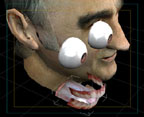
Stelarc's Prosthetic Head
"...Words like "intelligence", "awareness" and "agency" describe particular and peculiar behaviors performed effectively and appropriately in certain locations and situations. We do not need to imagine that they indicate anything other than that. What is important is not what happens within us, but rather what happens between us in the medium of language in which we communicate, in the social institutions within which we operate and in the culture within which we've been conditioned -- at this point in our history and so on, depending on our frame of reference. To talk of agency is to refer to an intentional act defined within a very small frame of reference. [...]
In the body performances, the skin has been stretched, the body has been probed and its limbs have been extended. The interest is to construct alternate interfaces that explore the absent, alien, involuntary and automated. What we experience is emptiness, ambiguity and uncertainty. We fear what we have always been and what we have already become -- a zombie with no mind -- a body that performs involuntarily..." From Prosthetic Head: Intelligence, Awareness and Agency by Stelarc, 1000 DAYS OF THEORY, C-THEORY, VOL 28, NO 3, Editors: Arthur and Marilouise Kroker. Also see Stelarc's Prosthetic Head by Julie Clarke.
Posted by jo at 10:35 AM | Comments (0)
September 30, 2005
The Spectrascope
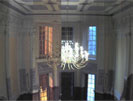
Haunted Pixels
Spectrascope, by Susan Collins, collects an image via a camera at the rate of one pixel a second from a haunted manor house - South Hill Park in Berkshire, England - and transmits it to the exhibition in Manchester, via the Internet, where it is projected onto a 6 ft screen. The image works its way across the room from top left to bottom right in vertical lines. At a resolution of 320 x 240 pixels each complete image represents the previous 21.33 hours of time and is updated continuously, with peculiar changes in light and fluctuations and inevitable 'ghosts in the machine' creating a sense of suspense.
The Spectrascope also introduces the 'fear frequency' to the gallery. This audio frequency of 19hz is just below the range of normal hearing, but it has been linked to distorted vision (including spectral images), discomfort, and "irrational" fear and has been found to be present at sites of "haunted locations". Introducing this frequency to the gallery invites the viewer to question whether the frequency itself is creating the disturbance or whether the site of haunting is creating the frequency.
The installation explores how images can be coded and decoded using both light and time as building blocks for the work. In the Spectrascope time is counted across the room from top left to bottom right in vertical lines.
The installation is part of the StoryRoom exhibition. 11 October 2005 - 15 January 2006 at the Museum of Science and Industry, Manchester, UK. [blogged by Regine on we-make-money-not]
Posted by jo at 12:41 PM | Comments (0)
Mapping New Territories
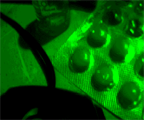
LOL (laughing out loud)
LOL: On jan 12th 2003, in Phoenix (USA), a 21-year old computer addict (called hereafter by his nickname "ripper") died of an overdosis of prescription drugs while chatting on the internet. Soon after this tragic event, a text file containing a transcription of the dialogs that occured in the chatroom appeared on numerous websites. Re-processing the dialogs recorded before, during and after his death, the N3KROZOFT MORD multimedia group expands the network tragedy into a caustic ectoplasmic seance.
"...N3krozoft Mord, a collective of media artists based in Geneva, have used the chat log as the script for a re-enactive performance. "The idea was to run this through again, like the film that runs before your eyes just before you die." The title LOL – the online acronym for "laughing out loud" – takes the chat’s commonest statement and uses it to describe the reactions of the participants as they sway between cynicism and helplessness..."
From the Mapping New Territories we site:
PERFORMANCE: 12.03.05, 19:00
The Fatal Failure of Telecommunications
LOL – a performance by N3krozoft Mord
[02:03:40]
[02:03:46]
[02:03:51]
These are the opening lines of an internet chat on 12 January 2003. Ripper is the code name of 21-year-old Brandon Vedas, who was to die at his home in Phoenix that night after taking a cocktail of prescription drugs while chatting with online acquaintances who were watching him on webcam. This tragic incident made the daily papers all over the world and within days, several websites had posted a chat log.
N3krozoft Mord, a collective of media artists based in Geneva, have used the chat log as the script for a re-enactive performance. "The idea was to run this through again, like the film that runs before your eyes just before you die." The title LOL – the online acronym for "laughing out loud" – takes the chat’s commonest statement and uses it to describe the reactions of the participants as they sway between cynicism and helplessness. Actor Nicolas Goulart plays Ripper, going through the actions that can be deduced from the text: Ripper sits, seems restless, drinks, smokes. He swallows pills. He broadcasts himself on webcam and, above all, he types intermittently at the keyboard. The actor replaces the original webcam footage, which was not recorded, and at the same time is the fictitious embodiment that recalls the lost presence of the dead man.
All the while, the chat log is screened in real time like film credits rolling: for 80 harrowing minutes the time code of the dialogue determines our sense of time. Life Images from a webcam focused on the actor are also screened. The authors of N3krozoft Mord intervene subtly in this sober yet obsessive repetition of the event. The footage of a second, moving camera is manipulated in situ as though mirroring the dying man’s drug-fuelled mental state. A troubling live sound track of booming sub-bass and high-frequency dissonance by the musician, 10111.org, underpins the moving image. The grim setting of Ripper’s desk, covered in equipment, paper, ashtrays, pizza boxes and glasses, is adapted from the opening scene of the film Matrix.
N3krozoft Mord’s manipulation of sound and image has a subliminal impact. It heightens the hypnotic magnetism of the authentic text, creating a mental space that acts as a resonator. Soon we find ourselves reacting as the participants did in the chat of January 2003, watching the bright green text unfold on the darkness of the screen, so mesmerised that we forget the reality unfolding in the room.
The virtual room in which Ripper and others are chatting is mainly about the abuse of prescription drugs. Press researchers have put the average age of the participants at 16. Ripper lists the drugs and the amounts and invites the others to watch him on webcam. Within 4 minutes and 9 seconds Phalaris has posted the cynical diagnosis: "attempted suicide # 84". At first, Ripper is egged on: "You pussy, you pussy, eat more." He takes it as a challenge, and boasts about his drug consumption and sexual exploits: "this is usual weekend behaviour, I told u fucks, u all said I was lying." Once it becomes clear that he is heading for a lethal overdose, some of them try to reason with him. Smoke2k writes: "look dude fucking cram it up your ass ... thats crazy ya know ... don't eat it... your already numb." Others send urgent virtual cries: "riipper ... RIPPER :((((" They even discuss whether to call the emergency services. But then they have their doubts – maybe Ripper is just acting out a suicide scene. Can the webcam be believed? Oea tries to call his bluff, then tries to coax Ripper back to life with a declaration of love. The medium heightens the kind of inaction that sometimes sets in among witnesses to a road accident. "you will never know if he died unless he get back on here," writes theKat, and grphish replies: "i know ... thats kinda freaky."
Another media-specific factor confuses matters: Pnutbot, who enters the conversation repeatedly at certain keywords, is not a human being capable of decision and action, but an automated chat robot. It remains a moot point whether Ripper himself programmed Pnutbot to throw in the poison control emergency number in a vain attempt to create some security within the casual framework of the chatroom. The kids in the chatroom are smart enough to find out, within seconds, the IP of the server and, with that the actual address of the anonymous Ripper. They have details – the lethal dose, the home address, the fact that his mother is in the room next door killing time with crosswords. But they do not add the bits together to a conclusive or binding narrative. Still less do they manage to translate them into the reality of the outside world and actually intervene.
In the chatroom, the gulf between simultaneous presence and absence offers protection, the liberty of risk-free intimate communication and a sense of belonging. In this serious situation, however, the same gulf becomes an insurmountable barrier. The young people are held back by the question as to what is real about what is happening in the virtual room. Or, to put it another way, what is fictional about the reality of what is happening. And quite a few of them cannot resist the temptation of simply withdrawing from their masked existence with impunity, from a chat that usually leaves only data trails, rarely corpses.
The simultaneity of presence and absence is mirrored in the setting of the performance without moral judgement. The audience is given a glimpse into both rooms, which cannot be brought together – neither in the actual incident nor in the performance. The gap between physical room and chatroom, between body and language, seals Ripper’s fate.
The N3krozoft Mord group, whose name itself combines computer and death, is interested in the subconscious, darker sides of telecommunication: "In the case of this chatroom protocol, what is unique is that the trail of the event itself describes the event. And it is a text that would not exist without the technical tools by which we communicate. It records and witnesses the death of a young man, but at the same time it is a statement about the vehicle of communication. ... The notion of telecommunication has always been linked with death. Even Edison’s phonographs were meant to record the voices of people so that they could still be heard after their deaths." The morbid aspect of telecommunication is also the subject of N3krozoft Mord’s latest audio work. Ubik is based on the sci-fi novel of the same name by Philip K. Dick, which describes how technology is used to retain the consciousness of the dead. With proper treatment, individuals become "half-lifers" and can communicate by voice from this semi-dead state, a kind of technically generated limbo. Fiction infiltrates our experience, whereas in Laughing out Loud, it is exactly the opposite: the fact of death tries in vain to penetrate the surface tension of a virtual community.
[02:55:32]
[02:55:46]
Text: Raffael Dörig und Annina Zimmermann
Credits
LOL – a performance by N3krozoft Mord
Idea & concept: N3krozoft Mord
Video projection, programming, installation: N3krozoft Mord
Audio: 10111.org
With support of: Bundesamt für Kultur/sitemapping.ch
www.n3krozoft.com
www.10111.org
Posted by jo at 09:47 AM | Comments (0)
September 21, 2005
The Digital Zoo

Telematic Interaction with The Big 5
The Digital Zoo, by radarboy, is reminiscent of tamagotchi nurturing, explores our emotional relationship with technology and how we relate to and treat wild animals within the context of a zoo. It was produced for the Low-Fi & Stills show in Edinburgh.
The five animals are Africa's Big 5: lion, leopard, buffalo, elephant and rhino - once the most sought after to hunt, but now mostly reduced to tourist icons. Visitor sends text message to the Zoo. The message is interpreted and forwarded to the radarboy server. The relevant animal and action is invoked and a response is written to the database. SMS confirmation reply to sender.
The Big 5 can be fed, played with, and nurtured into adulthood. Neglect will lead to a decline in health and ultimately their death. Their well-being can be monitored via SMS in the gallery and via the internet at home. Try it! Click here and send a message to a lion. [blogged by Emily on textually.org]
Posted by jo at 05:41 PM | Comments (0)
September 19, 2005
the Space Between the Physical and the Virtual
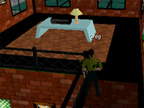
Cognitive Agents in 3D Virtual Worlds
"Abstract: We present an agent-based model of virtual worlds in which the objects in the world have agency, that is, the objects can sense their environment, reason about their goals, and make changes to the environment. The agent-based model has the following reasoning processes: interpretation, hypothesizing, and action activation. This agent model is described and illustrated using a wall agent in a multi-user virtual world. We extend the illustration through a demonstration of a multi-agent world in which many of the objects in the world interactively reason about the use of the world and respond specifically to the people in the world." From Cognitive Agents in 3D Virtual Worlds by ML Maher, JS Gero, G Smith, N Gu, University of Sydney, Australia; International of Design Computing, Vol 6, 2003.
Also: Interfacing Virtual & Physical Spaces through the Body: The C y b e r P R I N T Project

"Abstract: The cyberPRINT is a fully immersive, interactive virtual environment that is being generated in real time based on physiological data readings of a human body. In other words, the cyberPRINT is based on creating interfaces between physical and digital spaces and between biology and information technologies. The cyberPRINT is also an event, wherein a performer is connected to the cyberPRINT generator to create a self-sustaining feedback mechanism. Although the use of the body to electronically drive music and media events is not new, most of these works have paid little or no attention to the potential of interactive 3D virtual environments. Nor have they been so technologically advanced, interdisciplinary intensive (involving Architecture, Choreography, Modern Dance, Music, Bioengineering, Medicine and Computer Science), or architecturally focused as the cyberPRINT.
This project covers a wide and fertile territory that goes from the very technical and design oriented to the very theoretical and interdisciplinary. This paper is intended to (1) expand what has been already published about this project (Bermudez et al 2000a) and (2) establish potential areas for discussion before and after the performance."
1. Introduction: Why a Live Performance?
This paper provides background for the live performance of the cyberPRINT, a real time, physiologic data-driven virtual architecture developed by an interdisciplinary team led by two architects during the past 5 years. The reason for this live performance and demonstration is simple. It is only through performance that we can show the true nature of the cyberPRINT. Such demonstration will also provide empirical proof of the theoretical claims and technological details already published elsewhere (Bermudez et al 2000a). In addition, this version of the cyberPRINT will add some novelties occurred since then (such as a new virtual world, data-driven music in real time, a navigational data-globe). Images of a live performance are shown in Figure 1. [via]
Posted by jo at 11:38 AM | Comments (0)
September 16, 2005
The Knitting Map

Knitted Cartography
The Knitting Map is a fabric art and technology project that aims to take the pulse of the city of Cork (Ireland) during 2005 and translate that information into a live knitting map. Above the earth there is a satellite which looks down at Cork (Ireland) and watches the movements of people and cars around the city. Down in the hub, small cameras watch the city in detail and meteorological equipment tastes the weather. All of the data coming needs to be distilled into two simple numbers: one representing stitch (pattern) and the other colour.
There are 25 knitters, so information must be varied slightly between each knitter to give the overall textile a more subtle and complex hue. Knitters work in relay, the strips sewn together to form a single vast document of the city. Before each of them, a small digital screen details the next few lines of knitting and they lean forward to advance the pattern. During the day, people arrive to view the installation. By performance company half/angel. Pictures. Part of Cork 1005, Capital of Culture. [blogged by Regine on we-make-money-not]
Posted by jo at 10:30 AM | Comments (0)
Wind Array Cascade Machine
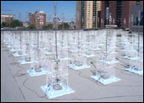
Si(g)n(e)
"Wind Array Cascade Machine (WACM)--by Steve Heimbecker--is a device that captures the wind's direction and movement and then streams the resulting data on the Web and uses them for installation projects. Thanks to the 64 motion sensors forming a grid of 8 units by 8 units, the system "maps" the wind in an outdoor space. Streamed on the Web, the data from the 64 channels are then processed by a computer program and assigned to installations that translate them into another form.(1)
The system has already spawned an installation, Pod, presented at the Mois Multi 2003 in Quebec City, as well as at the Subtle Technologies conference (2003) at the Interaccess centre in Toronto. During these two presentations, the sensing device was placed on the roof of the Méduse complex in Quebec City, and the data transmitted by the network were used to control a series of corresponding light emitting diodes (LEDs) placed on long vertical rods in an exhibition space.
Installed for a full year (2004-2005) on the roof of the Ex-Centris complex in Montreal, WACM powered the August 2004 Pod presentation at the Kiasma Museum of Contemporary Art in Helsinki, Finland, as part of ISEA 2004, as well as its presentation at Oboro in Montreal in November and December of the same year. The resulting luminous installation evoked a windswept field of wheat, thereby creating a visual analogy to express a natural phenomenon that is hard to perceive.
This system is similar to other devices created by artists integrating natural elements (for example, the wind and sun) into kinetic art. Yet Pod differs from this work in that the wind isn't used for its energy potential but rather because it describes a space by occupying and modifying it. Such projects are motivated by a fascination for natural phenomena, a desire to incorporate them into the creative process in order to link us to nature in technological contexts that sometimes exclude us and tend to distance us from our own organic condition.
In addition, Heimbecker is working on the project Si(g)n(e), a sound installation using the same system. To carry out this project, the artist is designing a sine wave generator with 64 channels, which will be controlled by a programming environment linked to a corresponding multi-channel sound system. The technology is being developed within a residency in cybernetic art at Vidéographe thanks to a program funded by the Foundation (2). Si(g)n(e) harks back to the many sound portraits of outdoor spaces produced by Heimbecker in the past." --S.P. © 2004 FDL [via]
Posted by jo at 09:12 AM | Comments (0)
August 24, 2005
Appendix2
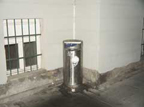
Activated by Passers-by
Appendix2--by Tanja Vujinovic and Zvonka Simcic--features an alternative state of urban landscape. The multimedia exhibition consists of short video works and interactive, computer based works displayed in the Kresija Gallery (Ljubljana, Slovenia) and interventions in the soundscape of the center of Ljubljana.
Small scale mechanisms (automata), made of sensors react to movement and small broadcasting units are hidden at several locations in the center of the city. Sounds are activated by passers-by and intervene into the structure of the town soundscape.
The sensors are attached to the garbage bins and passers-by are then blessed with sounds of Chinese market and rickshaw drivers, laundry machine and parody ads for perfume. Well, I should write "the sensors WERE atached" as they've just been stolen. Fortunately, the rest of the exhibition is still up and running till August 28. [blogged by Regine on we-make-money-not]
Posted by jo at 10:30 AM | Comments (0)
August 17, 2005
R&Sie(n)’s Dandy & Mutant A-life Architecture

I’ve heard about…©
R&Sie(n)’s Dandy & Mutant A-life Architecture by Joseph Nechvatal: R&Sie(n)’s exhibition “I’ve heard about…©” opened on the 6th of July at the Musee d’Art Moderne de la Ville de Paris‘s temporary space at the Couvent des Cordeliers - and I think it is one of the most relevant exhibitions to what is going on in art today that is of importance. R&Sie(n) is an investigational architectural firm consisting of François Roche, Stéphanie Lavaux, and Jean Navarro; working here with Benoît Durandin. Together, they utilize generative heterogeneous mutations in the creation of proposed utopian city spaces. In fact what they propose at the Musee d’Art Moderne is the artificial growing of extruded urban housing (generative & robotic) - where new cities are constructed via robotic processes by feeding off the carcasses of older dying cities. Very viral. Envisioned is an approach to city planning based on growth scripts and open algorithmic procedures. Towards these ends the show itself includes some subtle audio tracts, model-sculptures, a fully immersive hypnosis chamber with video monitors, booking services, 3D movies and robotic drawings/plans that reveal the source code of the generative program at the heart of their work.
There is a definite tangled and intertwined approach to the city vector that reminds me of the dithyrambic visual hyper-logic which has manifested in all modes of decadent artistic periods; from the Hellenistic and Flamboyant Gothic, to the Mannerist, Rococo, and Fin-de-Siècle - as they all opposed dogmatically imposed ocular paradigms with hyper-engendering strategies of form. The multiplicity of its interwoven experiences challenges the now bogus idea of simplicity – a modernist-minimalist idea which has taken on the intensity of a righteous injunction in many cities where the implied equation between simplicity, surveillance and goodness obscures a less evident function: that of cognitive constraint. Such constraint runs counter to what Georges Bataille considered to be the non-hypocritical human condition, which he took as being roused non-productive expenditure (threshold excess) entangled with exhilaration. For the finest comprehensive overview of Bataille's thought in this regard, see his book Eroticism - but also Denis Hollier's book on Bataille's general postulates, Against Architecture.
Given the organic-like, biomorphic architectural forms R&Sie(n) spawn by their generative program, I could not avoid thinking about the Palais Idéal of Ferdinand Cheval (1836-1924) - which to my eyes appeared to be one huge budding edifice when I visited it a few years ago - as if the stupendous mannerist grotto-façade at villa Borromeo had been left to grow untrimmed and run amok. However, the Palais Idéal was constructed by the postman Cheval alone and by hand in the Hauterives (Drôme) (near Lyon) between the years 1879 and 1912; the result of 93,000 man hours of hard labour. R&Sie(n) rightly prefers the work to be accomplished through a computer programmed emergence via artificial intelligence which directs robotic execution. Why should humans physically work when we might better be playing and dreaming?
The other inescapable reference for R&Sie(n)’s work is the visionary city-planning put forth by the Situationists. One thinks immediately of Guy Debord’s essay On Wild Architecture, for example. Like the Situationists, for R&Sie(n), the urban form no longer depends on the arbitrary decisions or control over its emergence exercised by the elite few. Ultimately R&Sie(n) leads us towards juicy Situationist-like complexities and engagements by way of immersion into an open-ended multiplex conceivable as a virtual environment: the Virtual Reality experience.
As R&Sie(n) say themselves, “Many different stimuli have contributed to the emergence of “I’ve heard about…©” and they are continually reloaded. Its existence is inextricably linked to the end of the grand narratives, the objective recognition of climatic changes, a suspicion of all morality (even ecological), to the vibration of social phenomena and the urgent need to renew the democratic mechanisms. Fiction is its reality principle…” Ahhhhh, the domain of decadent art, VR and artifice. Against Nature.
What has been somewhat poorly determined however is the degree a dweller feels totally immersed in an optically excessive space. And this depends to a large extent on personal psychological need and adaptability in accord with the proposed spatial depth cues. Cognitive-aesthetic space has to be coordinated phenomenologically with the proprioceptive space of the eye - and R&Sie(n)’s only failure is in maintaining the evident structural seams of the immersive faux-hypnotic chamber (the only enterable structure and the highlight of the show) because what the entire show is proposing is a seamless immersion into generative totality, and the visual seams take us out of that exquisite fantasy. So they are denied the loveliest of triumphs.
A pity, as one might otherwise imagine oneself totally immersed there somewhat like a 21st Century dandy. As at the birth of the 20th Century, this new hyper-dandy constantly might affirm his or her originality down to the decorative details of the home. In that the robots are doing the algorithmic planning and building, this work definitely proposes a new form of dandyism - if dandyism’s defining characteristic is remembered to be the making of one’s person a work of art while extolling laziness and displaying contempt for work. Evident here are the Baudelairean/Duchampian dandy ideals of impassivity, nonchalance elegance, and inscrutability. What matters are the triumphs of a radical contempt for one’s “hand”.
Indeed one can say that “I’ve heard about…©” favorably extolled artificiality, indifference, impassiveness - the reign of an ironic causality and knotted ambivalence, while staying open to all transactions. Most importantly, a-life forms are embedded within it and its growth is artificial and synthetic. So R&Sie(n) maintains a version of transcendental phenomenological idealism, but they do not disavow the extant actuality of the material sphere. Instead they seek to elucidate the sense of the world-as-is today - that is viractualized – by stressing the embodied nature of human and artificial consciousness and bodily existence as the original and originating material premise of sense and signification.
All told, the show is well done – as proposition. However this proposition inevitably turns the mind to the actualized imposing suavity of Antoni Gaudí’s fully realized wavy architectural shapes in Catalonia. Although he did not travel about Europe, Gaudí was aquatinted with fin-de-siècle Belgium/French avant-garde movements because of the intimate relationship between Barcelona and France and with the pre-modernistic movements of Arts and Crafts, Gothic Revival, and Impressionism which were discussed in the intellectual proto-modernist circle which he frequented. But it was Victor Horta's Art Nouveau movement that influenced Gaudí the most, stimulating him to experiment with new materials and new fluid shapes that appear grown. Gaudí's version of Art Nouveau is characterized by an overwhelming proclivity for the organic nature of women, beasts, and plants which he translated into immersive utility.
Antoni Gaudí is a chief exponent of R&Sie(n)-type open algorithmic building procedures precisely with his 1906 building Casa Batlló located at 43, Passeig de Gràcia, Barcelona - noticeable for its organic tactility of bones and shells within, and its external cocked surf façade and chimerical roof. With Casa Batlló, Gaudí accomplished an astute transformation of an existing building, transforming it into an enchanting immersive gesamtkunstwerk as Gaudí thoroughly undertook the design of every single element of the building, from the extravagantly protuberant façade to all aspects of the interior, including the gracefully gnarled furniture. On the exterior Gaudí was able to combine a flamboyantly surging façade (in an ingeniously cool-color orchestration) while maintaining a dialogue with the neighboring Casa Ametller (1900), built by Josep Puig i Cadafalch (1869-1956) four years earlier. Powerful pillars which resemble the substantiality of mammoth elephant legs accost the visitor at street level, protruding into the sidewalk, nigh tripping up an unaware pedestrian. These legs are bordered by a craggy vertebrae-like tier and the wavy façade extends upward between these two biologically evoking forms, culminating at the roof in a gargoylesque humping crescendo. The façade itself, coated in a layer of Montjuïc stone, shimmers seductively under the sun in multifarious chameleon-like colors; fraught with a scattering of small roundish plates resembling fish or reptilian scales. Affixed to this seething mass of swelling construction are a number of small, elegantly curved balconies with oval shaped portholes.
The entire structure feels unsharpened, flowing and smooth in opposition to the street itself on which the arrangement sits, with the exception of a few square windows up top. Even the walls are gently rounded in strained undulation and contraction, as if they too have entered into the oceanic female throws of a fluttering uteral orgasm. The walls appear to be made of a soft, smooth, supple, leathery material and this illusion of softness is carried through by the roundness of the inside forms of the building where one has the feeling of being pleasantly encased in an expanse of hardened dripped honey. Turning, lunging stair railings are met, engulfed and supplemented by softly heaving honey-colored walls and wooden biomorphicly shaped carved doors and irregularly shaped windows. There are no right angled corners or straight lines, which offers an impression of being wrapped up in one continuous fluid wave motion, complimentary with the exterior. By comparison, R&Sie(n) still has a ways to go in achieving a like sensuality of its avant-garde stance. But one only hopes for them an immediate success in doing so.
Credits:
R&Sie(n) = François Roche, Stéphanie Lavaux, and Jean Navarro with Benoît Durandin
With the production and authorship of :
-Berokh Khoshnevis (Contour Crafting Process, USC, LA)
-Francois Roustang (Hypnosis specialist, Paris)
-Chris Delaporte (Film director, 3D effect, Paris)
-Christophe Berdaguer & Marie Pejus (Artist, Marseille)
-Mathieu Lehanneur (Designer, Paris)
-Laurent Genefort (Science Fiction writer, Paris)
-CNRS Grenoble, Laboratoire de Spectrometrie (Nano Particules)
-M/M (Graphic designer, Paris)
-Gilles Schaeffer (mathematicien, Paris)
-Michel Boulcourt (Landscape architect, Paris)
-Alexandra Midal (Author, Paris)
-Matthieu Kavyrchine (Video artist, Paris)
-Sebastien Szczyrk (Sound designer, Paris)
-Alexandre Merlet (Video producer, Paris)
-Stephan Henrich (Architect, Germany)
-Providence (Singer)
Prototype / installation / publishing
-Ufacto, David Toppani (prototype scale 1)
-One Star Press (neighbourhood protocole publishing)
-Christian Hubert Delisle (prototype)
-Thibaut Boyer (installation)
-Jean-Michel Castagné (electronic driver)
Sponsors, partnership
MAM Paris-Musée (F), MUDAM (L), De SINGEL (B), USC (USA), KANAZAWA 21st century museum (J), CNC / Dicream, (F), LAFARGE (F), Materialise (B), Next Limit Technologies (SP), DAPA (F), University of Architecture Innsbruck (OST), New-Territories (F)
Show closes the 9th of October. Musee d’Art Moderne de la Ville de Paris / Couvent des Cordeliers / 15 Rue de l'ecole de Medecine / 75006 / Phone : 0156813321
Images and more info available at: www.mam.paris.fr
Even more info available at: www.new-territories.com
Posted by jo at 08:06 AM | Comments (0)
August 07, 2005
The MARS PATENT
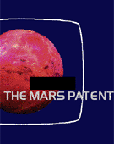
The First Interplanetarian Exhibition Space
The MARS PATENT--by Claudia Reiche and Helene von Oldenburg--is the first interplanetarian exhibition space. You are invited to experience culture on a fascinating and promising new site. Millions of miles away the red planet now lies within your reach – in an entirely new way. Since the early days the MARS PATENT committee has been working hard to find a discriminating place for your desires which allows a new sight on Earth: The MARS PATENT offers its MARS EXHIBITION SITE (MES) to you as a free experimental area and invites every thing which does not fit entirely on Earth but tends towards the MES. A thing? A real thing? Could be your idea, your object, your work, your question, your protest, your project, your desire. Mars – still untouched by human hands – is a dry, cold and poisonous place and often experienced to be of terrific beauty.
The Mars Exhibition Site (MES) is located near the equator in the north of a lowland area named Elysium Planitia. MES is a floating area. Its slightly changing form is a strung-out rectangle. Think of an area of approximately 3148 square kilometers offering a wide range of altitudes within a rocky landscape filled with incredibly shaped lava masses - exposed to storms and temperatures varying rapidly between -127 °C and +15 °C.
The MARS PATENT is a place for art and theory and sensible to its various concepts. With MARS PATENT's HRM_1.0n (High Reality Machine) we offer cutting edge technologies for installing sculptures, Internet relay chats, kinetic objects, art-and media theories, science fiction literature, telepresence systems, videos, sound installations, manifestos, web-art etc. by teleportation. This machine will become a potent device in your hands to place your things on the MES.
The main feature of the HRM_1.0n is the signal transmission with the ‘sender’ located on Earth and the ‘receiver’ located on Mars. The teleportation by the HRM_1.0n signifies an irreversible transfer from Earth to Mars. No matter treated by the HRM_1.0n will remain undamaged – from slight atomic disturbances to even more destructive effects. We differentiate a) Matter-Signal-Matter-Transformation (complete teleportation), b) Signal-Matter-Transformation (signal realization), c) Matter-Signal-Transformation (matter realization). HRM_1.0n’s Capacity of Signal Processing Rate: 1027 Tetra Flop/sec. Transmission Shaft Size is 32cm x 24cm x n cm.
As a controlling device THE MARS PATENT additionally provides an ongoing live-report from the local situation of the project’s area, the MES Attention: female first names only will be accepted! The question “If I'm not of female , could I register under a female name?“ is answered in the MARS PATENT’s Frequently Asked Questions: „The HRM_1.0n (High Reality Machine) is not able to control the biological identity. It's your commitment that counts“, even “ If they [the aliens] come up with a real e-mail address, they can always try. With a female first name we encourage every alien to participate.“ The „female privilege“ rule is thus carried out strictly symbolically and processed by the HRM_1.0n’s binary structure. Send your thing to the MARS PATENT!
CREDITS
Concept, content, design, performance: Claudia Reiche, Helene von Oldenburg.
Programming: Alexandra Bialas.
Contributors until July 2005: Ellen Nonnenmacher, Marina Grzinic, Dellbrügge & de Moll, Flora Urania Museum für werdende Kunst, Lena Eriksson, Judith Siegmund, i-love-u, Reva Stone, Gisele Bone, Maya Consuelo Sternel, Iana Krachounova, Stephanie Dean, Claudia Raddatz, Eugenia Gortchakova, Anna Pein, Doro Carl, Susan Chales de Beaulieu, Pio Diaz, Katherine Williams, Jamilia Jazylbekova, Saide Sesin, Paula Hasenzucker, Ma-tha-B Dao-in-space, Ursula Palla, Christina Goestl, Alice Bartle, Sandra Hastenteufel, Maria Deslibes, Maria Miranda, Norie Neumark, Out-of-Sync Collective, Valéry Grancher, Krista Beinstein, Phyllis Green,Chiara Passa, Louis Christian, Deb King, Amanda Steggell, Pernilla Platou, Anna Bardi, Ulrike Bergermann, Gisela Weimann, Sarah Smiley, Lowry Burgess, Naomi Nooteboom, Helen Varley Jamieson, Ada Frankiewicz Collaborations. [via rhizome]
Posted by jo at 07:48 AM | Comments (0)
August 01, 2005
R*Emote Mirror
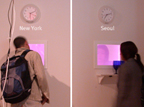
Hole in Space Update
R*Emote Mirror--by Yeonju Shim--is a pair of networked interactive lighting installations that creates communication between isolated people in urban cities and their loved ones who live far away. The telepresence installation re-creates feelings of togetherness and physically connected interaction between distances and spaces, allowing each person to interact through the expression of his or her movement. r*Emote Mirror has two functions: one is a mirror, and the other is interactive color lighting. Each r*Emote Mirror will have an initialized color representing the user, and trigger the movement of the person with different colors. When two persons stand at the same position in front of their installations, r*Emote mirror makes them see color changing and blending of their individual colors.
If you are living in Seoul and are close to the mirror, you can see your own shape on the panel in red light. At the same time, your friend living in new york can see your red color on his or her panel at home. if your friend is close to the panel, s/he can see his or her own body shape as blue light. If you are both in front of each mirror, the overlapping of color will hopefully evoke feeling of togetherness. For instance, if red overlaps with blue, it makes purple. [blogged by Regine on we-make-money-not]
Posted by jo at 11:35 AM | Comments (0)
July 08, 2005
Where are you?

Re-Enchanting the World
Enter the Panoscope 360° to be fully immersed in a 3D world. A 3-axis joystick will let you and your friends (up to 8) fly through the space as in dreams. The immersive display uses a PC and a hemispheric projector to project in real time a rendering of your entire horizon onto the screen.
In Where are you?--by Luc Courchesne--visitors are invited to fly, as in dreams, through a world of many dimensions, using a joystick to move in the X, Y and Z axis of a space where scale matters.
At scale 0, the world looks like a simple XYZ grid defining the experience of the navigable space. At scale +1, the world turns into an archive of pictures, sounds, texts and objects. Zooming out at scale +2, elements of this archive become particles in a "molecular" world of self-organizing clouds of lights. Zooming yet further out at scale +3 reveals a landscape of mountains and valleys.
At any moment in the Where are you? world, visitors may come upon other beings: live ones through telepresence links, pre-recorded subjects in video windows and themselves when cameras transmit their own image in this constructed world. In Where are you? the visitor controls his/her position, the path and speed of his/her journey and the scale at which he/she is prepared to "exist". Video demo. [blogged by Regine on we-make-money-not]
Posted by jo at 01:58 PM | Comments (0)
June 24, 2005
Synthecology
![CWall_04[1].jpg](http://www.turbulence.org/blog/images/CWall_04[1].jpg)
Garden of Sonic Lifeforms
Synthecology, a tele-immersive collaborative project with a new architecture for virtual reality sound immersion to create a garden of sonic experimentation for visitors to explore and cultivate. Synthecology invites visitors to create a musical sculpture of sythesized tones and sound samples provided by web inhabitants. Upon entering the garden, each participant can pluck contributed sounds from the air and plant them, play their own improvisation or collaborate with others to create a new composition.
As each new "seed" is planted, grown, and played, the garden becomes both a musical instrument and a composition to be shared with the rest of the network. Every inhabitant creates, not just as an individual composer shaping their own themes, but as a collaborator in real time who is able to improvise new soundscapes in the garden by cooperating with other avatars from diverse geographical locations. Synthecology will debut at NEXTFEST2005 in Chicago, June 24-26, 2005. [blogged by Regine on we-make-money-not]
Posted by jo at 03:05 PM | Comments (0)
June 21, 2005
Ctrl-C Ctrl-C
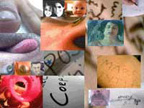
De-Territorialized Bodies
Ctrl-C Ctrl- C, by Corpos Informaticos, is a telepresence performance that explores the possibility of poetic interaction in a telematic environment, the notion of the absent body which participates in an affective aesthetic experience, using the Internet as a space of realization and the public [on-line and live] as co-authors of the work.
Telepresence performance takes place on the World Wide Web. It involves de-territorialized bodies, reorganized [re-orphans] in monitors that are dispersed in the world. The Internet, a net of communication, is in fact a net of information. In telepresence performances, subjectivities are connected in real time, in direct communication; interlocution. The concept of Performance Art widens itself: an ephemeral and presence-oriented art, can it be virtual? How much [or how much longer] is the spectral body able to arouse emotion, affection? What is the concept of "group" for the one who extends oneself and becomes part of the Internet community? The collective work that requires such openness of its members is now open to numerous, infinite participants with different perceptions of interlocution. This communication, a truthful sharing, is it only an idea of encounter? For Performance Art in telepresence, is it an opening for the body to became spectral? Or is it just submission to the demands of the machine?
Posted by jo at 10:32 AM | Comments (0)
June 10, 2005
RealityFlythrough

Harnessing Cameras "In the Wild"
RealityFlythrough is a telepresence/tele-reality system that works in the dynamic, uncalibrated environments typically associated with ubiquitous computing. By opportunistically harnessing networked mobile video cameras, it allows a user to remotely and immersively explore a physical space. Live 2d video feeds are situated in a 3d representation of the world. Rather than try to achieve photorealism at every point in space, we instead focus on providing the user with a sense of how the video streams relate to one another spatially. By providing cues in the form of dynamic transitions, we can approximate photorealistic telepresence while harnessing cameras “in the wild.” [via]
Posted by jo at 08:15 AM | Comments (0)
May 12, 2005
In Camera
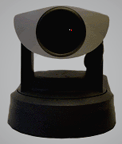
Robotic Webcam Embedded in Multi-User Environment
In Camera, by Isabelle Jenniches, is a series of portraits after Douglas Coupland's "Life After God." It was presented at Versionfest>05 in Cicago
During live events viewers can choose to either actively control the camera's point of view and zoom level or to passively observe other user's choices. Images and text may be saved and stored in a shared archive. Excerpts of Coupland's text are superimposed upon the webcam images that show the characters in everyday surroundings such as kitchen, forest or work place. Caught in a loop of activity, struck by a frenzy or interrupted in a daydream, they incorporate Coupland's quest for meaning and soul searching in Life After God.
Posted by jo at 10:03 AM | Comments (0)
May 09, 2005
Fundamental Practice

In Response to the 'Unknown'
Based in New Zealand, as far from Venice as you can get, the group et al. will use the internet to monitor and make changes to their installation at the 51st Venice Biennale of International Art. This will allow group members to continue working in New Zealand and around the world while retaining 24/7 contact. Et al.’s installation, The Fundamental Practice will be representing New Zealand at the 51st Venice Biennale of International Art.
Central to et al.’s work is an exploration of the human tendency to establish truths and orthodoxies in response to the ‘unknown’. It is a concern that is reflected in et al.’s long-standing choice not to reveal their identities. The group is currently steered by one artist who remains anonymous outside the title et al., thereby protecting her own mutability, and the homogeny of the group.
Posted by jo at 05:00 PM | Comments (0)
April 20, 2005
InterPlay: Loose Minds in a Box
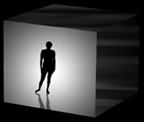
Six by Six
InterPlay: Loose Minds in a Box is a collaborative work that explores the basic concept of the "box". The box is a metaphor for the physical, social, political or psychological constraints that we and/or others place upon us. The box also represents a sense of place in the realm of the virtual as well as in our sub-conscience. InterPlay is a multi-faceted telematic event that consists of six simultaneous performances that occur in six states throughout North America. The performances incorporate theater, text, music, performance art, virtual reality, and motion capture and are concurrently captured, mixed, digitized, encoded and streamed onto the network.
Posted by jo at 08:42 AM | Comments (0)
March 31, 2005
Can You See Me Now in April

Blast Theory performs again their first hybrid reality game
Can You See Me Now?, the hybrid reality game developed by U.K.'s group Blast Theory and Nottingham University's Mixed Reality Lab will be perfomed twice this upcoming month of April in Cambridge, U.K. People from all over the world are able to play online on the virtual streets of Cambridge against Blast Theory's runners on the real city streets. To participate, you need to log-in to the game's website (Can You See Me Now) on April 1-3 from 2-5pm (GMT) or on April 6-8 from 4-7pm (GMT). A more extensive explanation of the game can be found at the same website.
Posted by at 07:39 PM | Comments (0)
March 30, 2005
Multimodal Telepresence and Teleaction
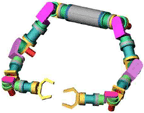
Telepresence, Haptic and Networked-Control Systems
"Telepresence has been defined by Prof. Thomas B. Sheridan in 1992 as a system in which the human operator receives "sufficient information about the teleoperator and the task environment, displayed in a sufficiently natural way, that the operator feels physically present at the remote site". Hence a telepresence system enables a human operator to perceive and manipulate a remote environment.
A telepresence system consists of three components. The human system interface (HSI) is handled by the human operator. He/She commands the teleoperator to perform actions in a remote environment. HSI and teleoperator exchange command and feedback signals over a communication line.
To achieve a holistic remote immersion, multiple modes of human perception are addressed including haptic, visual, and auditory senses. The level of the immersion is called the transparency of the telepresence system. To reach this goal telepresence conglomerates three disciplines: robotics, telecommunications and virtual reality.
Intended applications for telepresence systems are telesurgery, teleassembly and teleservice systems. In hazardous environments, for example, multimodal telepresence will provide significant benefits. As illustrated in the figure below search-and-rescue operations could be done by a tele-commanded robot reducing risks and increasing efficiency." Continue reading >>
Posted by jo at 07:30 AM | Comments (0)
March 25, 2005
Eliza Redux

A Robot Who Talks Too Much
Eliza Redux--by Adrianne Wortzel--is an interactive telerobotic web site providing a space for text-to-speech and oral discourse, acting out, and playfulness in the virtual environment of a psychoanalyst's waiting room and inner office. Video and audio of a real physical robot is streamed to the web reactive to visitor text input. Issues of control and lack of control become paramount for the user. Wortzel is implementing ways to bring Weizenbaum's original 1966 ELIZA program into the 21st century.
Wortzel is seeking a computer science professional or student in the New York City area who can lend his/her skills to an internet-broadcast robotic art installation. She is looking for a developer to facilitate communication between clients running flash applications, a server database, and an extremely talkative robot.
Job Requirements:
- SKILLED DEVELOPER in jsp, flash, xml.
- Be able to learn a pre-existing set of commands from the robot control interface.
Ideally, you will also
- Have understanding of database retrieval & modification
- Patiently explain technology needed to execute high-level art ideas
- Be willing to troubleshoot & debug until things work right, everything from web-cams to multiple socket connections.
Job length: Immediate start, completion deadline -end of May.
You will receive at the very least a $500 stipend, and experience/credit in a robotic art installation bound for gallery showing. An article about the project is coming out in the June issue of the prestigious Journal: Leonardo. Plus, you'll get to work in a tech-decked paradise lab with fun people and an even more fun humanoid robot. Even if you don't have all the skills outlined above, we're very interested in hearing from people who are enthusiastic & quick at learning. To apply, contact Prof. Adrianne Wortzel at muse(at)cooper.edu or cell: 646-567-9648
Posted by jo at 01:19 PM | Comments (0)
March 22, 2005
LF:TK Experiments in Telematic Dancing
[CLICK ON IMAGE: You'll need Quicktime to view this movie] Experiments in Connected Social Spaces - LF:TK - Kinetic Live Art through the Internet.
Posted by jo at 07:38 AM | Comments (0)
March 10, 2005
Co-Opticon
![]()
Democratic Optics
The Co-Opticon (a.k.a. the ShareCam) is a machine for democratic optics, allowing a network of participants to cooperatively control the viewpoint of a shared video camera. The co-opticon combines a networked robotic video camera with a graphical user interface that allows many internet-based viewers to share simultaneous control of the camera by specifying desired viewing frames. Algorithms compute the optimal camera frame based on all requests, and position the camera accordingly.
Posted by jo at 05:38 PM | Comments (0)
Questioning: a reflection on the Demonstrate Project

Found Questions
"ABSTRACT: This reflection on the Demonstrate project, a public and collaboratively-controlled state-of-the-art robotic web camera installed in historic Sproul Plaza, features a selection of user-generated questions, taken directly from the captions of user photos and from the user comments that appear below photos in the Demonstrate archive. They have not been edited, and they appear in the same chronological order in which they were originally asked. Together, these “found questions” are intended to evoke the sense of playful inquiry, practical curiosity, political engagement, sense of audience, and self-reflexivity that developed within the Demonstrate community. Their unfolding over time captures the shifting dynamics that emerged among users, and between the watchers and the watched." From Questioning: A Reflection on the Demonstrate Project, written for Making Things Public, an art-technology exhibition at ZKM Karslruhe (March 2005). Collaborators on the Demonstrate project and exhibition: Ken Goldberg, Dezhen Song, Andrew Dahl, Jeremy Schiff, Irene Chien, Jane McGonigal and Kris Paulsen.
Posted by jo at 05:17 PM | Comments (0)
March 03, 2005
Social Tele-Presence
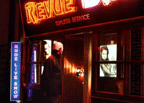
Rent-a-Body
"Tele-presence can be defined as the experience of being fully present at a live (non-virtual) location remote from one's own physical location. Effectively removing the visual and aural senses from the body’s location and having them operate in real time from somewhere else...
...In the same way that to a degree the eyes of a dog can enable a blind person to see, their legs can be used to enable people to walk whilst remaining stationary. In this way the user can window shop from home or take a walk in the country...
...Through the rent-a-body service the customer can rent the physical body of another person. The rented body effectively has his senses removed, he can see nothing and hear only the voice instructions of his user. His body becomes literally a host. This enables the customer to either visit ‘socially’ inhospitable, unethical places or to attend meetings or events without physically being there." From Social Tele-Presence by Auger-Loizeau
Posted by jo at 10:04 AM | Comments (0)
March 01, 2005
IN Network

Living Together While Apart
IN Network--by Michael Mandiberg and Julia Steinmetz--is an extended cell phone life-art performance about distance, communication, intimacy, telepresence, and living together while apart. Faced with the prospect of a long-distance relationship when Michael moved from Los Angeles to New York in August 2004, the two artists got their frequent flyer numbers handy, and switched both of their cell phones to a provider with free "IN Network" service.
During the month of March the artists will present this cell-phone life-art performance via a photo moblog and podcasts of their phone conversations. There will also be several live webcasts of audio of the artists sleeping together on their cellphones. They will route all of their text and picture messages through the IN Network website. If you'd prefer, you can have installments of the performance sent directly to you via their Podcast. How to Podcast?.
"IN Network" is a 2005 commission of New Radio and Performing Arts, (aka Ether-Ore) for its Turbulence web site. It was made possible with funding from the Jerome Foundation.
BIOGRAPHIES
MICHAEL MANDIBERG is a new media artist who uses the internet, video and performance to explore subjectivity, labor, and commerce. His projects include "Bush Poll," a statistical survey of the 170 George Bushes of the United States, 2004; the DVD exhibition "First Person" in collaboration with Carla Herrera-Prats and Anne-Julie Raccoursier, 2003; and "The Exchange Program," a collaborative performance, 2002. Mandiberg has exhibited at Ars Electronica Center, Linz, Austria; ZKM in Karlsruhe, Germany; Transmediale Festival, Berlin; Tirana Biennale, Albania, and C-Level, Los Angeles. His work has been reviewed in The New York Times, The Chicago Tribune, The Berliner Zeitung, Wired, and a new survey "Internet Art" published by Thames and Hudson World of Art. Mandiberg is Assistant Professor in the Department of Media Culture, at the College of Staten Island/CUNY. URL: http://www.mandiberg.com/; Contact: michael -at- mandiberg -dot- com
JULIA STEINMETZ is a founding member and co-director of the Toxic Titties, a Los Angeles based collective working in performance, video, photography, and new media. Their work has been performed at such venues as Museum On Contemporary Art, Seattle, REDCAT at the Walt Disney Concert Hall, Out Fest Film Festival Los Angeles, LA Freewaves festival and the Hammer Museum in Los Angeles. Titties have performed in events such as the "Intersectional Feminisms" conference at UC Riverside, CA and at "Outside Field: International Performance Festival" at Ex-Teresa Arte Actual, Mexico City, "Cyberfem Spirit," at Edith Russ Site for New Media, Oldenberg, Germany and at Schnitt Ausstellungsraum, Cologne. Their work has been written about in Tema Celeste, the Los Angeles Times, the LA Weekly, Mexico City's La Reforma, Black Book Magazine, and Kolner Stadtanzeiger. Toxic Titties performance documents and design work have appeared in "Gendered Geographies," edited by Kaucyila Brooke, and "SITE, Schinitt Austellungsraum" published by Krefeld, Germany. Their work in collaboration with Austrian artist Dorit Margrieter was recently featured at MUMOK in Vienna. Contact: juliasteinmetz -at- yahoo -dot- com
Posted by jo at 11:53 AM | Comments (1)
February 24, 2005
Liveform Telekinetics [LF:TK]
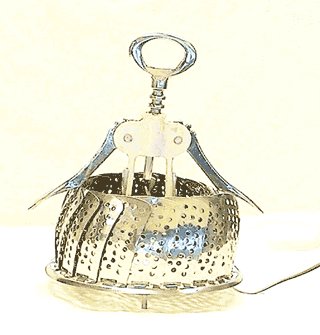
Experiments in Connected Social Spaces
"...Sharing a meal, a walk in the park, weddings, sports, or cafés...are the kind of social activities and rituals we associate with human relationships...What if you could go out for dinner and dancing with friends, even though you're a thousand kilometers away?...(W)ireless Internet "hotspots"...provid(e) the possibility of multi-situated presence, but (are) also placed within a fixed physical location, a social environment rich with familiar objects, rituals and codes of behaviour.
LF:TK takes a playful approach to the ways we might inhabit such a hybrid environment. Furniture, decorations, cutlery, bric-a-brac and cultural debris are reconstructed as networked interfaces that populate surfaces within everyday social spaces. Each object provides a simple function, yet when combined with others helps build a complex arrangement of movement and gesture. Imagine a shared creation, a social ritual, a dance through objects, a table that is played." [Recipe for Corkscrew Man]
Posted by jo at 05:34 PM | Comments (0)
The New Performer: Data as Performer and Performance
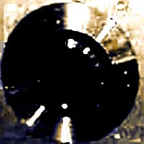
In Pursuit of the Virtual Performer
"The nature of all performance includes the elements of time-based experience and space as "stage". I use the term "stage" as a simple reference point to describe the space in which a performer performs and not as reference to the theatre. The nature of performance in the computer age includes these elements of time and stage as space. A simple definition of performance is : that which is feigned or pretended. It is action. It is speech. It is anything performative. The nature of the performer includes any entity who/which feigns, pretends, acts, and speaks. So, it is natural to include non-human entities, such as robots, cyborgs, and databases in this discussion of performance. Baudrillard might describe performing and the performer as more real than real, so real that they are virtual. "Of course we have a multitude of objective, real proofs, but what does one do with historical reality in a system which itself has become virtual? "(1)
New media's complex nature has influenced the nature of performance to become something many don't consider performance. Anything involving action, interaction, time, and space is performance. Therefore, performing is both real and virtual, becoming more real than real through the very nature of simulation. Performance on and of the net includes everything from virtual actors (interactors) interacting with real actors, Moos, Mud's, Mucks, Games, Chat groups, telepresence, Database as performance. The performer is data. The performer is virtual. The history of virtual performance begins with interaction between the real and hyperreal in time-based experience in a space referred to as the stage." From The New Performer: Data as Performer and Performance by Sheila A. Malone.
Posted by jo at 08:11 AM | Comments (0)
February 18, 2005
ORNITORRINCO IN THE SAHARA
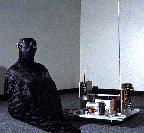
Dialogical Telepresence Event
"On October 5, 1996, Ed Bennett and (Eduardo Kac) participated in the IV Saint Petersburg Biennale with a dialogical telepresence event entitled Ornitorrinco in the Sahara. The phrase "dialogical telepresence event" refers to a dialogue between two remote participants who interacted in a third place through two bodies other than their own. Telepresence refers to the experience of having a sense of one's own presence in a remote space (and not the sense of somebody else's remote presence, as is common on the telephone). Realized in a public area of a downtown building in Chicago,..the event...consisted basically of three nodes linking the downtown site in real time to The Saint Petersburg History Museum... and the Aldo Castillo Art Gallery, located in the well known Chicago gallery district. Through these telecommunications ports of entry human remote subjects interacted with one another by projecting their wills and desires onto equally remote and fully mobile, wireless telerobotic and telecyborg objects."
Other Articles by Eduardo Kac:
TELEPRESENCE ART
DIALOGICAL TELEPRESENCE ART AND NET ECOLOGY
NEGOTIATING MEANING: THE DIALOGIC IMAGINATION IN ELECTRONIC ART
BEYOND THE SCREEN: NEW DIRECTIONS IN INTERACTIVE ART
INTERACTIVE ART ON THE INTERNET
TELEPRESENCE ART
ASPECTS OF THE AESTHETICS OF TELECOMMUNICATIONS
WRAP AROUND THE WORLD
Posted by jo at 09:09 AM | Comments (0)
February 17, 2005
From A to D and back again:
![]()
The Emerging Aesthetics of Interactive Art
"...Screen-based 'hypertextual works', 'instrumented physical spaces' and 'mapped virtual and real environments' are three new genres. Another 'dimension' can be added to each of these by the inclusion of fast, wide bandwidth digital communications technologies. We might call this tele-interactivity. There are identifiable sub-genres, in which the interaction is: between people geographically separated; between a person and a machine, geographically separated; or between people geographically separated at a virtual site.
The first we might call 'teleconferencing art'. Paul Sermon has produced provocative works in this vein, such as Telematic Dreaming...A second sub-genre utilises the idea of teleoperation. Eduardo Kac and Ed Bennett's Ornithorinco allows a user to teleoperate a robot (over phone lines) to explore an environment.
More provocatively, Stelarc's recent Fractal Flesh project allows his body to be teleoperated over the net. In both these works some aspect of the user (vision, volition) is extruded over the communication network to 'be' in another place. A third sub-genre (exemplified by Agnes Hegedus' Fruit Machine) allows multiple remote users to cooperate in tasks in a shared virtual environment.
The sudden explosion of networked multimedia (via the World Wide Web) has finally realised the dreams of the pioneer network artist of the mid eighties, (though this realisation has a decidedly commercial cast to it). A recent network project by the Berlin based Art+Com group, T-Vision is on the one hand chillingly panoptical, on the other it demonstrates coordinated global data retrieval in a way that the WWW only hints at. "T-Vision" offers a radical new paradigm of computation. In this work, a user rolls a beach-ball sized trackball, and a globe of the world presented on the screen, rolls correspondingly. This image is made up of a patchwork of satellite and aerial photos. This world can be zoomed. In some cases one can zoom from the entire globe down to a city street in one smooth swoop. In one case, one can zoom into the Art+Com office, and look through a video camera pointing out the window, and see real time video action! "T-Vision" can utilise the entire internet, drawing on dispersed databases for its images, so that the globe is continually updated, even to the extent of real time video, if available..."
From From A to D and back again: the emerging aesthetics of interactive art by Simon Penny, Leonardo Electronic Almanac, Volume 4, No. 4, April 1996.
Posted by jo at 08:30 AM | Comments (0)
February 10, 2005
Dziga Vertov Performance Group
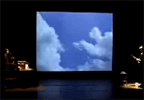
Performance Hybrids
Founded by artist/director Douglas Rosenberg in 1991, Dziga Vertov Performance Group's purpose is to create works bridging numerous disciplines including dance, performance and the visual and media arts. It takes its name from the Russian filmmaker of the early 1900's. DVPG's fundamental mission is to create new and challenging works of art based in the language of performance, dance and media that often combines voice, text, video and projected images. The work of DVPG is concerned with both content and form. The purpose of the work is to engage the audience, other artists and community groups in a dialogue that reaches beyond the usual performer/spectator relationship. In order to do this, we have set out to create a hybrid form of performance that is intended to both engage and challenge, using concepts and images that speak to contemporary and historical issues of human existence.
One of DVPG's many projects is ADaPT, an interdisciplinary association of artists, technologists and scholars from five educational institutions dedicated to research and critical dialogue on performance and media in telematic space.
ADaPT comprises five dance studios in five universities in the USA.:
1. Arizona State University
2. Ohio State University
3. University of California-Irvine
4. University of Utah
5. University of Wisconsin
In Wisconsin, the ADaPT team consists of Douglas Rosenberg (principal investigator), Chris Dowling (telematic technologist) and Jeffrey Gray Miller (technical director).
The objectives of ADaPT are to:
* create a site for telematic collaborative inquiry for the purpose of developing new models of practice and training techniques for the creation of networked dance and performance
* explore embodiment and somatic intelligence through reconceptualization of spirit, body and machine in Internet 2 culture- develop a shared mediated space for investigating performance and creative collaboration through a distributed environment across time zones
* situate research within a larger cultural and political context that acknowledges how mediated performances both frame and are framed by issues such identity, privilege, and access.
Posted by jo at 11:48 AM | Comments (0)
February 08, 2005
Eyes of Laura
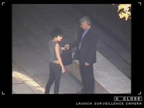
I Love Surveillance
I received this note a few days back:
Hello, I am Laura, a security guard at the Vancouver Art Gallery. Through work, I have access to a lot of security cameras. I hacked a way to put one of these online on my Website so you can see it and control it. I love surveillance and keep a web journal or blog of what I see and put up video and images of things that happen.

The obvious reference had me Googling for an online synopsis of The Eyes of Laura Mars. (Nice one, Laura!) [originally posted by Joy on newsgrist]
Posted by jo at 06:30 PM | Comments (0)
Internet Performances as Site-Specific Art

Telematics and Performativity
"The following analysis is driven by the thesis that Internet Performances should be approached through site-specific art and its theory. To approach Internet Performances as a site-specific art is a – both theoretically and historically – promising premise. First, this positions Internet Performances in the 20th century tradition of experiments between both the performing and fine arts on the one hand and media technology on the other hand. Second, the concept of site-specific art emphasises the transformed modes of perception in telematic Internet Performances. These transformed modes of perception are influenced by the Internet’s mediality." From Internet Performances as Site-Specific Art by Julia Glesner published in Body, Space & Technology Journal Volume 3, Number 1.
Posted by jo at 03:04 PM | Comments (0)
February 04, 2005
Breathe On Me
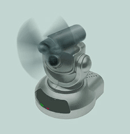
Breath as a Fundamental Form of Communication
Breathe On Me is an installation/internet work consisting of a three-walled space with a number of hybrid fan/webcam devices affixed to the walls. The fan/webcam devices are modified netcams such that Internet users can control the direction of a fan from the remote webcam view combined with pan and tilt controls. Internet users can choose one of the devices in the space, log onto the "FanCam," visually locate visitors in the physical space and then turn on the fan and "breathe" towards the person. Visitors in the physical space are invited to enter a space where they will be remotely seen and will not know who is telepresent. Once seen by internet participants, they will receive an offer of fan "breath" as a fundamental form of communication. Visitors who enter the space are asking to receive a telepresent stranger’s glance and touch in the form of wind. Internet users reach out to physical visitors in the simple offer of moving air.
To visit in telepresence: Links will to the live performance will be available at the live site within 24hrs. Opening Telepresently and in Situ: Friday, February 4, 2005; 8.00-9.30 PM, Pacific Standard Time, Continuing live through February 6; INTERACTIVE FUTURES 05: Technology in the Life World, Victoria, BC @ Open Space Artist-Run Centre
Posted by jo at 09:35 AM | Comments (1)
January 27, 2005
East by West
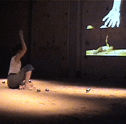
Fictional Geographies and Mediated Presences
"The concept of networked, translocal spaces allows investigation of the nature of real-time sound synthesis and how extended physical space can be shared by people when they play with fictional geographies, strange or familiar objects, and their mediated presences. Telepresence restructures and enlarges the environment with its projection (window) of mediated and combined presences in action. Linking a "local" site with a "remote" site raises particular challenges for our understanding of new artistic paradigms in telepresence, distributed and "navigational" art. The social orientation toward sensual environments and "hyperplasticity" is not directed at euphoric assumptions about virtual reality (VR) but at concrete, synaesthetic processes of cognition. East by West addresses the visitors' playful fantasy and tactile exploration of the environment; the interface becomes useful. If such play recognizes how parallel reality-systems can converge or affect each other, how we integrate other realities into our social experience."
Posted by jo at 09:44 AM | Comments (0)
Here I come again (Flying Birdman)

Between Sites and Non-Sites
Here I come again (Flying Birdman) was a telematic "earthwork" - an earthwork dance linking five remote sites in the United States with two locations in Brazil. It was based on narratives/dreams and structured spirally as a "Renga" (the old Japanese form of a linked poem) composed of live dance; real-time audio and sound processing, pre-recorded filmic images; still images, and both spoken voice and graphic text communication exchanged by participants during the live performance.
Thematically, the performances delved into "left overs," debris, decomposing sites, dumps, and the idea of re-cycling of landfills: what is returned needs to be transported from one site to another. The dramaturgy for this telematic "earthwork'" envisioned a spiraling dialogue/communication -between sites and "non-sites"- with at least 2 sites dialoguing with each other (video, audio) at any given time during the 10 scenes. The dialogue was passed on and moved around, as in the Renga for of a linked poem. The online viewer was invited to follow the spiral. View movies >>
Posted by jo at 08:56 AM | Comments (0)
January 26, 2005
The Dream Project

Reinforcing the Disparity Between Virtuality and Physicality
In the teleconference performance The Dream Project--by Keith Roberson and Company in Space--performers wearing datasuits control virtual avatars in a shared virtual reality environment. Bridging the gap between multiple locations, these avatars interact with each other. Their interactions explore possibilities beyond the physical body. Choreography of these virtual bodies, based on Quantum and Super-string theory, reinforces the disparity between virtuality and physicality.
Posted by jo at 11:13 AM | Comments (0)
January 22, 2005
Project Molly

Light Lunch with Molly
"Project Molly is a series of roaming interactive webcasts captured live using a wearable wireless audio/video acquisition system by artist Nichola Feldman-Kiss. Please interact with Project Molly live for light lunch and conversation via internet relay chat at the Project Molly interface."
Project Molly was a performance art/research innovation; it used a Xybernaut wearable computer with a head-mounted audio video acquisition and display system to stream a live video feed to the internet via wireless connection. The prototype real net video performances interactively linked the remote audience with the real time audience/performers via Project Molly’s personal a/v surveillance and chat interaction. Each consecutive interactive webcast incrementally evolved the project molly interface and knowledge database. Ultimately, the interface tracked project molly's movement through real space and captured streamed video into a data archive that is indexed and searchable by a variety of terms.
Posted by jo at 12:16 PM | Comments (0)
The Telepresence Garment
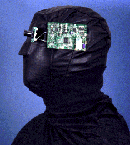
Engaged by Others, Remotely
"(Eduardo Kac) first conceived the Telepresence Garment in 1995 to investigate the notion of the mediascape as an expanded cloth; i.e., to consider wireless networking as a new fabric that envelops the body. The Garment, which I finished in 1996, gives continuation to my development of telepresence art. This time, however, instead of a robot hosting a human, we find the roboticized human body itself converted into a host. The Garment was designed as an interactive piece to be worn by any local participant willing to allow his or her body to be engaged by others remotely." Continue reading >>
Posted by jo at 12:10 PM | Comments (0)
January 14, 2005
800-178968

...I'll Call You
800-178968--by Luca Bertini--was a toll-free number that attempted to establish an obsessive and addictive relationship with individuals. It called people back, even after a few weeks, and pleaded with them to come back.
800-178968 was invasive, insinuating itself into the homes and mobile phones of people, violating their privacy, and becoming part of their daily lives. The advertisements for it--which began three months before the start of the service--were hidden among information channels (by adopting their language, codes and instruments), thus were able to reach an unaware, vulnerable audience. The project ended on July 2003 with over 10.000 people contacted. [via Rhizome]
Posted by jo at 09:30 AM | Comments (0)
December 27, 2004
netzwissenschaft
![]()
Emerging Infrastructures of All (Inter)net Research
Dr. Reinhold Grether's network research | netzwissenschaft site maps the "emerging infrastructures of all (inter)net research endeavours. net.science as an anthropology of connectivity is trying to overcome the constraints of specialist method transfers on net matters. the protuberance of technical networks necessitates a professionalization of human net knowledge. neither the isolation of concepts as in basic research nor the encapsulation of processes as in applied sciences will ever be able to adequately describe the complex autopoiesis of networks. net.science is undoubtedly developing into a scienza nuova of its own right."
Check out his Mobile Art and Virtual Performance research areas.
Posted by jo at 04:45 PM | Comments (0)
December 24, 2004
Telematic Dinner Party
![mike_fork[1].jpg](http://www.turbulence.org/blog/images/mike_fork[1].jpg)
A menu of food and electronics
During the experiment that Jeff Mann and Michelle Teran made of the Telematic Dinner Party, conversations between the table guests in Amsterdam and Toronto were mediated by streaming media and networked kinetic objects. So, for example a clinking spoon or glass in Amsterdam could produce a slamming door in Toronto.
The dinner table was turned into a physical platform for networked media supports live video streams, tele-robotic talking fish, gourmet cooking, singing chandelier, Keystroke media mixing, wine-pouring machines, telematic toasts, party games, etc; linking two dining rooms and thirty dinner guests across the ocean in a mediated mechatronic middle-space for social interaction.
Throughout the meal, the guests made toasts and speeches using the sensored and motored wine clinking devices. Everybody played games with food, cutlery, and chef attire to create interesting and coordinated video feed. After the first course, people changed seating arrangements to have access to all telekinetic props and streams distributed across the table. A coordinated storytelling game was played using the audio stream with the guests in Amsterdam. Finally, a punk magician performed for those physically and virtually present. (Posted by Régine Debatty)
Posted by Regine at 02:28 AM | Comments (0)
December 23, 2004
Pocket Perspective

Telepresence Event 12-23-04
Eric Redlinger and members of the Parsons MFA Design & Technology Program will be presenting Pocket Perspective, an interactive, online telepresence performance from 10:00am to 12:00pm on the morning of Thursday, December 23rd. All are invited to contribute audio, visual, and text media derived from the contents of your pockets. The live performance can be experienced in person or online.
Via Rhizome. (Posted by Régine Debatty)
Posted by Regine at 12:39 AM | Comments (0)
December 03, 2004
Spinne
![spinne_electro1[1].gif](http://www.turbulence.org/blog/images/spinne_electro1[1].gif)
Touching of the spider-web
Spinne, by Laura Beloff and Erich Berger (the duo from the Seven Mile Boots), is a networked audio installation of four sculptures made of plastic spheres, loudspeakers and metallic leg constructions. They correspond to four software programs, little search engines known as web-spiders that are sent out into the internet to chase some words or phrases. For example the word "women" can be searched from informational, religious, entertainment, and shopping sites.
Everytime a websurfer is accessing the website, the physical installation is reacting to it by shaking of the cables ("touching of the spider-web"), vibrating the speakers and modifying the soundscape. Little spider replicas are also placed on top of each loudspeaker membrane and the amount of the chased words can be heard and make the glass spiders dance on the membrane. Video.
Originally blogged on near near future
Posted by jo at 02:02 PM | Comments (0)
November 29, 2004
LiveForm:Telekinetics

Intertwined Networks
The Waag Society for Old and New Media has in 2004 commissioned Canadian artists Jeff Mann and Michelle Teran to produce and present the second iteration of the LiveForm:Telekinetics Project. LF:TK involves the creation of a series of site-specific installation/performance works connecting hybrid physical/virtual spaces using streaming media and networked kinetic objects. The commission is part of the Connected! project of Waag Society, a two-year programme of performances, lectures, workshops, installations, and emergent events exploring collaborative networked media and live art.
The LiveForm:Telekinetics project is envisioned as a laboratory that examines the intertwining of social networks and social spaces with their technological counterparts. As a work of art, it challenges and expands the notion of performance, the relationship of the artist and audience, production and exhibition, and ideas of locale and presence. The project creates hybrid installation/performative works, augmented with electronic devices and network systems, to create shared spaces and live social situations. Two-way streaming media such as video, sound, and graphics, are used to connect together physical sites via the Internet. Everyday physical objects within the environments become kinetic communications interfaces, animated with embedded sensors and actuators. In LiveForm:Telekinetics, mediating technologies are human-scale, built into architecture, furniture, decorations, utensils, toys, and the bric-a-brac that we surround ourselves with. Read more.
Posted by jo at 10:22 AM | Comments (1)
November 28, 2004
arm wrestling: new and old

The Challenge of Haptics
The Wall Street Journal has an interesting article on the technology behind haptics, derived from the Greek word meaning "to touch"...A group of science museums in the US is showing off one form of the technology. The system, dubbed the Internet Arm Wrestling Challenge, uses aluminum arms and hands connected by a series of rods and gears to computer servers linked to the Internet.
Visitors looking for a test of strength sit in front of a touch-screen monitor and ask the computer to look for a potential opponent at another museum. If one is available, his or her picture appears on the screen via streaming Internet video, the two wrestlers grip the metal hands and the computer starts the contest." [via]
We reported on an earlier form of arm wrestling in our post about the two Canadian artists—Doug Back and Norman White—who in 1986 used motorized force-transmitting systems interconnected by a telephone data link and did some telephonic arm wrestling of their own. "You could almost feel the pulse of the other person," White said, "... it was uncannily human-like--the sensation of sinews and muscle--not at all like feeling a machine."
Posted by newradio at 12:23 PM | Comments (0)
November 24, 2004
Mulholland Drive
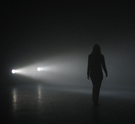
cinema sans image
In Mulholland Drive by D. Scott Hessels, three artists drove Los Angeles' famous Mulholland Drive with five types of sensors—measuring tilt, altitude, direction, speed, and engine sound. The captured data was used computationally to control two robotic lights in a dark room filled with fog. Two beams of light and the processed sound of the engine recreated the topology of the road as a new form of visual experience and sculpture—cinema without image.
Mulholland Drive is a light installation that translates the movement across a topology as two beams of light. Instead of direct human interaction, the work takes the sensed data (tilt, sound, and GPS) of traversing an environment and recreates the drive through angles, light, and sound. A passive interactive experience, the artwork emphasizes the spatial quality of light—it is cinema without image. Like cinema, direct data is captured, then edited, and shaped. However, here the environment directly defines the experience, using the geography computationally. In a sense, “Mulholland Drive” is a new media Earthwork and demonstrates how suddenly the rhythms, patterns, and random chance of the environment can be sensed through new media technologies and used to create new forms of visual experience.
Producing under the name Damaged Californians, Scott Hessels has released experimental art and commercial projects in several different media including film, video, web, music, broadcast, print, and performance for the last decade. His work has shown in international film and new media festivals, on television, and in contemporary art galleries. He recently completed a commission of three interactive films and six online movies for Australia and was honored with a career retrospective at the Melbourne International Film Festival. As a media artist, his installations have shown at CiberArt in Bilbao, the Hammer Museum in Los Angeles, and the Japan Media Arts Festival. Professionally, as Director of Information Technology for Fox Television, he was responsible for the systems, software, communications, and security for two television stations and two cable networks…a career he followed for 25 years. He currently teaches digital video at UCLA in the Design | Media Arts Department and is studying for his graduate degree in that field.
Posted by jo at 01:00 PM | Comments (0)
November 14, 2004
telezone
 more telematic embrace Telematic Connections at the Walker Art Center 2001 presented similar ideas about networked connectivity. WHAT'S CHANGED? We're STILL participatory, we're interconnected - WE'RE WIRELESS.
more telematic embrace Telematic Connections at the Walker Art Center 2001 presented similar ideas about networked connectivity. WHAT'S CHANGED? We're STILL participatory, we're interconnected - WE'RE WIRELESS.
Telematic Connections, like many of the works in it, is a hybrid affair. Part history, part speculation, partly onsite, partly online, it crosses boundaries between art, communications, and popular culture. Its four sections include installation works, past and recent film clips, online projects, and a "telematics timeline." Through these various media, the exhibition presents the ways in which artists use technology—and the Internet—to explore both the utopian desire for an expanded, global consciousness and the dystopian consequences of our collective embrace, willing or not, of computer-mediated human communications. At the same time Telematic Connections places this emergent work within a historical framework.
The eight installations that comprise the "Telereal" component of this exhibition use the Internet and computing to explore this mediated embrace between parties, whether human to human, human to machine, machine to machine, or even human to nature. Here, as well as in the ten online projects in the "Datasphere" component of the exhibition, what the visitor-participant does in the galleries affects (and is affected by) someone or something somewhere else in physical space. "The Virtual Embrace" signals this shift from the viewer as an observer to embracing us as a participant, integral to the work-process of art.
While Telematic Connections presents the possibilities for connections and affiliations, it still acknowledges a persistent question about connective new media. Artist, theorist, and teacher Roy Ascott stated it poignantly already in 1990, "Is there love in the telematic embrace?" Is there content besides technology? Engagement beyond entertainment? A message that is not only the medium?
Telematic Connections is not fundamentally about technology. Nor is it an attempt to define a new genre of art practice. It is about what MIT computer scientist Michael Dertouzos calls "the forces of the cave"—some of the eternal human traits that have never left us, including the desire to connect, even to merge with another—but in today’s world of ubiquitous computing and global networking.
The TeleZone project is a successful example of the integration potential of the Ars Electronica Center. If you look at the list of the persons and institutions who made this project possible - university institutes, technical college courses, the Telekom, the company Wittmann, a project manager who is both an expert in robotics and a student of philosophy, graphic artists, architects, programmers - it almost seems to be a textbook example of the synergy of art, science and research which is demanded ever so often, as well as of the combination of different fields of competencies which are required when faced with the task of dealing with the challenges arising in connection with the new digital technologies.
Apart from the above, however, it is also a prototypical experiment setting for investigating the modern information society based on these technologies. "Software code - more than law - defines the true parameters of freedom in cyberspace. The question of what the architecture of cyberspace should be is not a neutral question. We need to think about it in political terms." This observation by Lawrence Lessing, lawyer and professor at Harvard, puts a crucial issue into words. Which norms and conventions will determine the way we will live together in a world defined by global acceleration and networking?
The most fascinating novel aspect about the Internet, its cultural and economic potential lies in its publicity, the way in which - unlike in any other medium in the past - not only passive consuming is possible but active participation on a broad and general scale. Each participant may act as transmitter or recipient, whatever pleases them more. Owing to this simple technical fact the Internet becomes a lot more than merely a modern information medium - it develops into a strong infrastructure for a community.
Telepresence (in simple words, the possibility of becoming noticeable at a location where one is present only via a network connection).
Posted by michelle at 01:33 PM | Comments (0)
November 09, 2004
M.U.S.H.

Hyperkinetic Possibilities
M.U.S.H. (Multi-User Sensorial Hallucination) is an interactive audiovisual space in which two people in different locations (DEAF04 in Rotterdam and STEIM in Amsterdam) are connected to each other by means of telepresence equipment. The user enters a dark, silent room. S/he can use a navigation stick to activate sound and image. This brings the system into a "hyperkinetic" state: there is a chaotic play of sounds, ghostly images flash, shadows appear and disappear...If the user moves the navigation stick back and forth long enough, rapidly and slowly, the image of the person in the other Mush-Room will gradually appear on the large screen.
The users' movements create the opportunity for a virtual meeting between two strangers. M.U.S.H. is based on synchronicity and creates the conditions for the testing of telepathic possibilities. The navigation stick is a wireless movement sensor that registers the changes in the speed at which the viewer moves it. On the basis of this signal the computer changes the "choreography" and the play of sound and image. To be performed at DEAF04: see details below.
Location Amsterdam: STEIM, Achtergracht 19, Amsterdam
Date: 10 - 21 November, 14:00-16:00 hrs and 18:00-20:00 hrs
Reservations: tickets@v2.nl & (010) 750 28 90
Location Rotterdam: DEAF04, Van Nelle Ontwerpfabriek, Van Nelleweg 1, Rotterdam
Date: 10 - 21 November, 14:00-16.00 hrs and 18:00-20:00 hrs
Reservations: tickets@v2.nl & (010) 750 28 90
Posted by jo at 11:12 AM | Comments (0)
November 04, 2004
Net Guerrilla Ballet
![bi-ir_pr01[1].jpg](http://www.turbulence.org/blog/images/bi-ir_pr01[1].jpg)
wireless illegal remote-controlled net-ballet invasion
Ballettikka Internettikka is an ongoing study of the internet guerrilla performance.
Slovenian ballet dancer Igor Stromajer and composer Brane Zorman will be replaced by toy-robots which will invade the kitchen of the famous [theatre x] and dance an illegal wireless roboballet there. The robots and cameras will be remotely controlled from a mini-van parked in front of the [theatre x].
Live internet broadcasting of the guerrilla ballet performance will start on November 13th 2004 at 20:00 GMT+1 and will last 10 to 15 minutes; the location will be made public on November 13th at 18:00 GMT+1. [Via]
They will enter the kitchen of the famous [theatre x], where bio-food for artists is prepared. The kitchen of the [theatre x] is an excellent example of a modern cooking laboratory for healthy food. It is automatized and meets the highest hygienic standards. The artists will use two remote-controlled toy-robots with two wireless web cameras. Robots and cameras (algorithm of the ballet choreography and MP3 orchestra) will be remotely controlled from a mini-van parked at the north-east side of the [square x] in front of the [theatre x].
This time, Stromajer and Zorman (as ballet dancer and musician) will be replaced by robots, lonely and sad icons, automatized units, which will have no major problem to invade the kitchen of the famous [theatre x] and dance the net-ballet there. Toys transform into guerrilla-ballet dancers.
Stromajer and Zorman will approach the [theatre x] full of respect towards the [theatre x] and its rich history.
Artists will use hi-tech mobile and wireless equipment for the invasion and live broadcasting (portable computers, mini digital camera, MP3 audio systems, mobile WAP telephones etc). A laptop and MiniDV cam, together with Webcam32 (version 6.0) software will be used for broadcasting the video signal (running over Intima Virtual Base FTP server). Another laptop and MP3 player with online interface SHOUTcast (version 1.8.3/win32), will be used for live sound broadcasting (running over Beitthron FTP server). A local GSM mobile phone operator will be used for GPRS mobile internet connection.
# Timetable of the action in [theatre x] - 13. 11. 2004:
11:00 - test and calibratethe equipment, micro-locate at ground zero
19:30 - park mini-van at the north-east side of the [square x] in front of the [theatre x] and secure the location
19:45 - robots enter the kitchen of the [theatre x]
20:00 - start of the live internet broadcasting
20:15 - end of the internet broadcasting
20:20 - robots exit the kitchen of the [theatre x]
20:35 - leave [square x] in front of the [theatre x] and secure the material
Dancing an illegal wireless roboballet in the kitchen of the [theatre x] represents a big conceptual and strategic challenge to the Intima Virtual Base, therefore the preparations have been taken serious, safety measures have been calculated, and the previous experience from the Bolsh.oi Theatre in Moscow has been very welcome.
Note: [theatre x] does not voluntarily co-operate in the project, but was selected based on the conceptual strategy of the project. The management of the [theatre x] is not a co-producer of this project and does not co-operate in the process of its realization.
Project supported by The Ministry of Culture of the Republic of Slovenia
About the authors:
Igor Stromajer is an mobile intimate communicator. He researches tactical emotional states and traumatic low-tech strategies. He has shown his work at more than a hundred exhibitions in forty-two countries and received a number of awards. His works are included in the permanent collections of the Centre Georges Pompidou, Paris; the Museo Nacional Centro de Arte Reina Sofía, Madrid; Moderna galerija Ljubljana, Slovenia; Computerfinearts Gallery, New York.
Brane Zorman is a composer and sound manipulator. Between 1982 and 1986 he was frontman for the Slovene punk group O!KULT. He is a pioneer of Slovene techno scene. Since 1987 he has been composing music for both Slovene and international theatre, dance and multimedia performances and projects. and has made guest appearances throughout Europe. Recently he works with Irena Pivka on a
series of audio-visual installations ZONE.
Ballettikka Internettikka PRESS (2001 - 2003):
...The eleven minutes of live webcasting were watched by more then 400 people. An amazing amount, which even the artist did not expect. Not only did they see Igor Stromajer dancing, but they also saw the conductor of the 'mp3 orchestra' - as Stromajer calls MC Brane - who ironically conducted the mp3's on his laptop like a true Herbert von Karajan. The video of the whole event catches the excitement of the event well. Shot in black and white it leaves one a bit with the feeling of watching an avant-garde performance straight from the early twentieth century, if it weren't for the laptops and mobile phones of course. Both dancer and conductor wear a kind of miners light on their heads. The movements of the light, the speed and accuracy of the operation, the bare abandoned basement and the concentrated moves by Stromajer and MC Brane create a sense of conspiracy that replaces the so called interactivity of on line art without it being missed. In a way it is still there, in the intimacy of the small circle of people who watch this event live, while the management of the Bolsh.oi theatre watches a classical ballet.--# "Claiming the Stage: Ballettikka Internettikka pt 2" by Josephine Bosma, Cream, Amsterdam, Nizozemska (25.04.2002)
Posted by jo at 11:43 AM | Comments (0)
October 26, 2004
Ken Feingold

The Interactive Art Gambit
"Going back even farther in time, looking for cultural formations which are now familiar aspects of interactive art, I was struck early on by the essentially interactive nature of shrines, and other somehow consecrated public places. What differs here from the contemporary interactive artwork which relies on, as Crichton said, temptations and sources of curiosity--here the encounter is ritualized and made into theater. It is performative, highly prescribed and passed on from generation to generation. In the ritualized encounter, there is quite often an actual physical exchange which is also a symbolic exchange. One leaves something, in a certain way, and takes something away--usually as a mark upon the body. It is generally performed by simultaneous actions of touching and looking, but here, very importantly, and in most cases completely absent in interactive art, the voice of the participant plays an important role."
Read "The Interactive Art Gambit" ("Do not run! We are your friends!") by Ken Feingold, Technology in the 90s presentation, The Museum of Modern Art, NY, April 7, 1997.
Also from Ken Feingold's web site:
The History of the Interface in Interactive Art, Söke Dinkla, 1994
Seeking Deeper Contact: Interactive Art as Metacommentary, Erkki Huhtamo
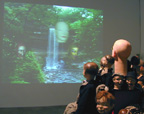
Self Portrait as the Center of the Universe takes up and extends the themes of Séance Box No. 1 (1998-99). The self-portrait animatronic head has open-ended, improvisational conversations with its alter ego, a virtual head that appears as the central figure in the projection. Like If/Then, the conversations between these two figures do not include the audience; rather, they interact only with each other. Their conversations are generated in real time, utilizing speech recognition, natural language processing, conversation/ personality algorithms, and text-to-speech software. The physical side of the conversation is performed by an animatronic figure (a speaking silicone cast of my head) and the central subjects of their conversations revolve around, on one side - generalization and distance; and on the other - questions and memories of himself. These conversations, bridging real and virtual spaces, are within video-like digital scenes that recompose themselves based on the nature of the conversation between the two main characters. The subject of the conversation, as determined by the artificial actor, controls the landscape which is seen, so these change as the conversations go along, and other figures appear and disappear. The scenes are also populated by figures - autonomous "software agents" in the form of realtime 3d computer animation - which appear in the projected image-world that fills his vision.
Posted by jo at 08:51 AM | Comments (0)
September 30, 2004
Teletravel
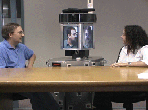
BiReality: Mutually Immersive Mobile Telepresence
BiReality uses a teleoperated robotic surrogate to visit remote locations as a substitute for physical travel. The goal is to create, both for the user and the people at the remote location, the sensory experience relevant for face-to-face interactions. The second-generation system provides a 360-degree surround immersive audio and visual experience for both the user and remote participants, and streams eight high-quality video streams totaling almost 20Mb/s over wireless networking. The system preserves gaze and eye contact, presents local and remote participants to each other at life size, and preserves the head height of the user at the remote location.
Posted by jo at 09:31 AM | Comments (0)
Teletravel

BiReality: Mutually Immersive Mobile Telepresence
BiReality uses a teleoperated robotic surrogate to visit remote locations as a substitute for physical travel. The goal is to create, both for the user and the people at the remote location, the sensory experience relevant for face-to-face interactions. The second-generation system provides a 360-degree surround immersive audio and visual experience for both the user and remote participants, and streams eight high-quality video streams totaling almost 20Mb/s over wireless networking. The system preserves gaze and eye contact, presents local and remote participants to each other at life size, and preserves the head height of the user at the remote location.
Posted by jo at 09:31 AM | Comments (0)
August 20, 2004
arm wrestling
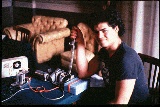
Telephonic Arm Wrestling
1986:
The setting was a bar-room. Two Canadian artists—Doug Back and Norman White -- were talking about the arms race.
"Wouldn't it be great," Back said, "if [the arms race] could be resolved by arm wrestling?"
And so the idea grew, “to allow contestants in two different cities to arm wrestle, using motorized force-transmitting systems interconnected by a telephone data link." Information would flow bi-directionally -- between identical robotic arms controlled by active agents at each of two sites.
After engineers at the University of Toronto estimated a cost of $75,000, the artists decided to try to build it themselves, and did. in two months for approximately $500 by throwing together “a bunch of junk" along with some homemade custom electronics.
The first successful implementation of the work took place between the Canadian Cultural Centre in Paris and the Artculture Resource Centre in Toronto.
Telephonic Arm Wrestling wryly established a low-tech system for resolving competitive, if not antagonistic relations. It was remarkably sensitive. "You could almost feel the pulse of the other person,” White said, “... it was uncannily human-like--the sensation of sinews and muscle--not at all like feeling a machine."
Because of the time-delays in the telephone link, the system could not support standard rules of engagement. It was impossible for the competitors to really have much of a fight. Under certain circumstances, both sides could win simultaneously, fundamentally undermining the competitive model of win-lose. In this case, there was no victor, only local perceptions, a telling commentary on the arms race and the opposition of capitalism and communism.
from looksmart "Tele-Agency: Telematics, Telerobotics, and the Art of Meaning" by Edward A. Shanken.
Other works (1969-1996) by Norman White
Posted by newradio at 05:46 PM | Comments (0)
August 01, 2004
Tele-Actor
Hello all:
I am really amazed by the amount of activity on the blog -- looks like we've hit on a potent topic.
One project I want to add to the mix is Ken Goldberg's Tele-Actor , which is now about two years old. People online vote on what they want an actor to do. That actor is equiped with a wearable computer, including cams, mics, etc.
From the website: "The "Tele-Actor" is a skilled human with cameras and microphones connected to a wireless digital network. Live video and audio are broadcast to participants via the Internet or interactive television. Participants not only view, but interact with each other and with the Tele-Actor by voting on what to do next. Our "Spatial Dynamic Voting" (SDV) interface incorporates group dynamics into a variety of online experiences."
It seems to me that many of the pieces mentioned so far not only are networked or distributed in nature, but also utilize non-linear narratives that have not been been predetermined. Coincidence?
Brooke
Posted by at 10:04 PM | Comments (1)

